
Please send all Checks and Money orders to :
Dave Taylor P.O. Box 87 Sylvania, OH 43560
419-842-1863
Click Here to E-mail Us!
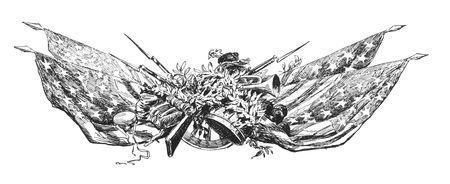
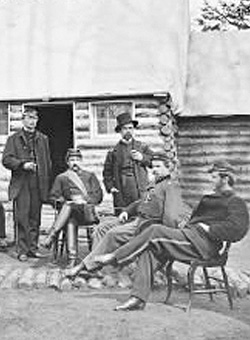
16-01-02
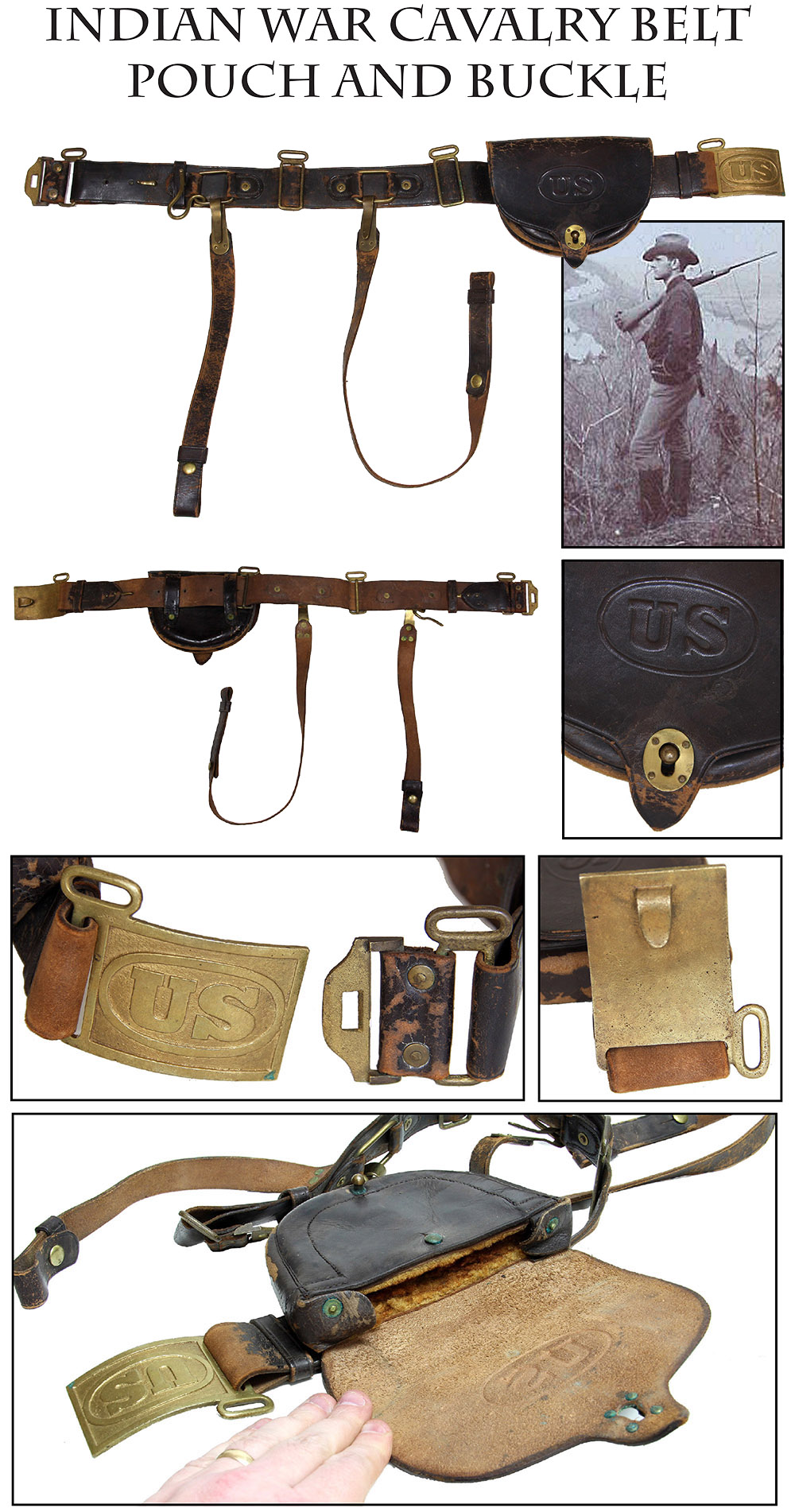
16-01-40 … INDIAN WAR CAVALRY BELT, POUCH, AND BUCKLE … Ultra rare Custer era US cavalry 1872 pattern saber belt mounted with an 1874 pattern Dyer cartridge pouch. Very nice condition throughout, just some minor scuffing at contact points where the plate or hasp has rubbed the leather. Sharp condition belt plate with its integral brace loop, both intermediate belt support loops for the brace system are in place as well, as is the three-piece hasp arrangement. Both saber detachable straps are present and there is a real nice 1874 Dyer pouch on the belt that has a lot of condition going for it. The US added four regiments of cavalry to the regular army after the Civil War, but this was a far, far smaller establishment than the wartime volunteers of the 1860s. Regulation cavalry accouterments of this period are consequently very rare. The 1872 Pattern Saber belt was a short-lived experiment using a shoulder brace system and is particularly scarce. Dyer pattern cartridge pouches were strong contenders in the 1870s competition to find a convenient method of carrying the new metallic ammunition. This one has very sharp embossing on the cover, just minor finish losses at points of flexing, and pretty much all its fleece interior. The fleece was intended to keep the ammunition from bouncing out of the pouch when the flap was open. It is thought some Dyer pouches may have made their way to Little Big Horn in a mix of saddler-made prairie belts and issue cartridge pouches. In any case, this rig is a very fine and very hard-to-find cavalry rig from the early Indian Wars … cjj-allis-17243 … $1,450.00 – SOLD
Call us @ 419-842-1863
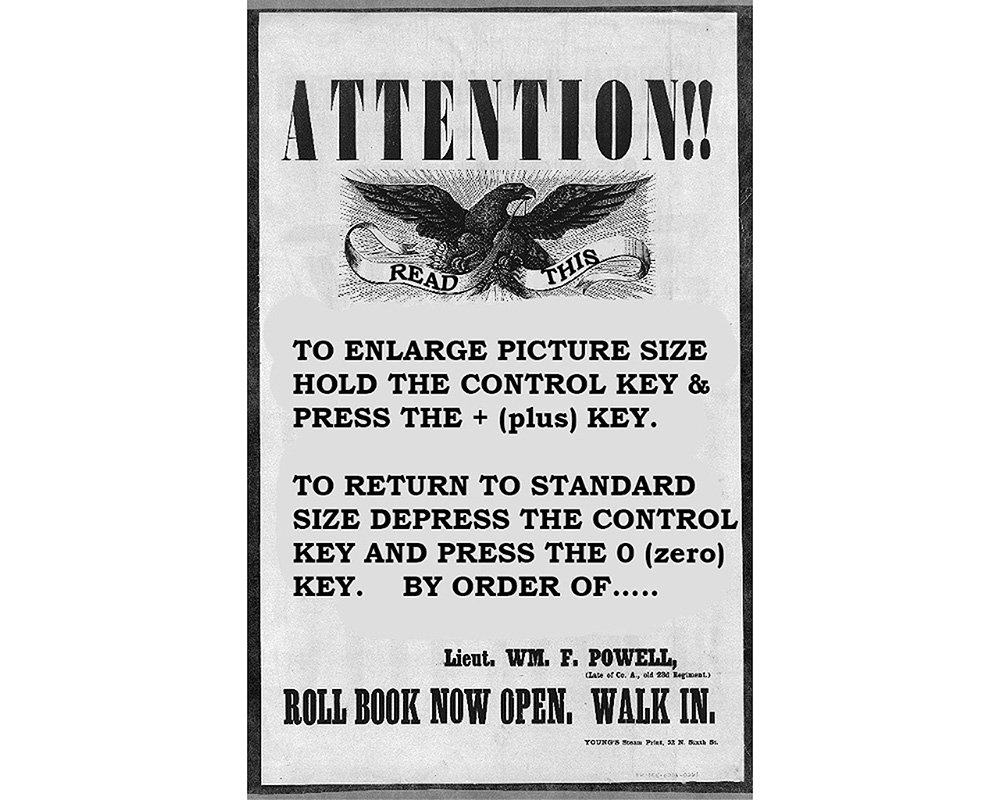

16-01-41 … CDV STANDING VIEW OF A 7th NEW YORK SOLDIER … Crisp early war view by Fredericks, New York, of a member of the 7th New York State Militia, one of the very early-war northern regiments rushed to Washington in 1861. Led by Colonel Marshall Lefferts, the regiment federalized three times. The first on April 19, 1861, just days after Fort Sumter. It mustered in for thirty days and served in Washington. In May, 1862, it went in again, for three months, and was stationed for most of that period in Baltimore. In June, 1863, it mustered in for another thirty days during the Gettysburg campaign, served at Baltimore and Frederick, Maryland, and then returned to New York City to help put down the draft riots in July. Our man holds his rifle at parade rest with bayonet fixed and has his overcoat thrown over one shoulder, showing its colored lining (the 7th NY had them lined in red.) He wears a low crowned cap with a “7” inside a hunting horn on the front, and around his waist seems to be an NCO belt, though no chevrons or pants stripes are visible. He has a serious look and a fashionable set of muttonchop sideburns with his moustache, giving him the appearance of a well-heeled member of that exclusive militia regiment. The fact he is wearing his overcoat suggests we are looking at an image of their first mobilization, when they rushed south to save the nation’s capital. A stong early war image … $295.00
Call us @ 419-842-1863
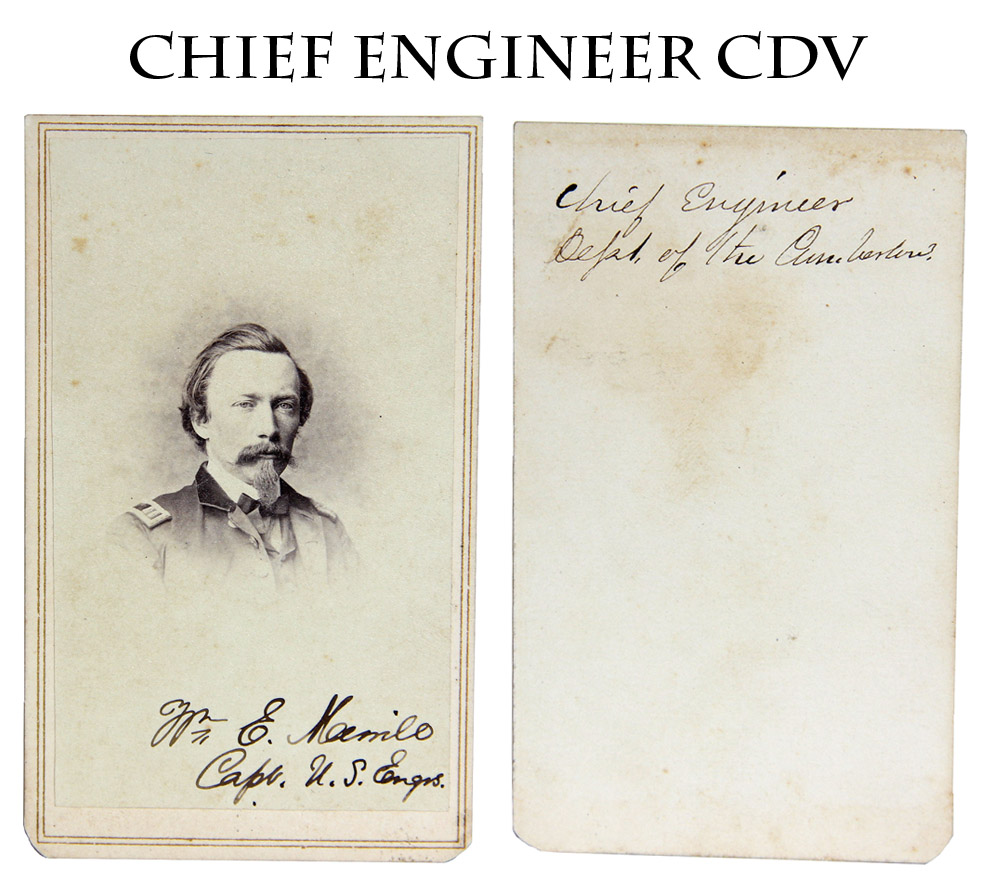
16-01-42 … “WILLIAM MERRILL CHIEF ENGINEER DEPT. OF THE CUMBERLAND” … Handsome vignette CDV bust shot of a dapper captain showing his shoulder straps on a casually unbuttoned coat. Nicely signed at bottom front: “Wm. E. Merrill / Capt. U.S. Engrs.” The US Engineers took the cream of the graduating class each year at West Point. William Emery Merrill was the son of a U.S. officer killed in the Mexican War at Molino del Rey, and entered the US Military Academy in 1854, graduated first in his class in 1859, and was appointed brevet 2nd Lt. in the Engineers 7/1/1859. He made full 2nd Lt. 2/20/61, while already serving as Assistant Professor of Engineering at West Point from September 1860 to July 1861. He made 1st Lt. 8/6/61, and served under McClellan in the Peninsular Campaign. He was promoted to Capt. 3/3/63. Appointed Colonel in the volunteer service, he commanded the 1st US Veteran Volunteer Engineers from 8/3/64 to 9/26/65 when he resumed his regular army career, making Major of Engineers 3/7/67 and serving on Sherman’s staff in the Military Division of the Missouri until 1870. He represented the US Army Corps of Engineers at an international congress of engineers in Paris in 1889, and died in 1891, still on the job, on his way to a government project in Illinois. Merrill saw a lot of service during the war, earning a number of brevets: Captain 4/16/62 for gallant and meritorious conduct in an engagement with the enemy before Yorktown, Va.; Major 9/19/63 for faithful and meritorious service at the Battle of Chickamauga, Ga.; Lieutenant Colonel 3/13/65 for faithful and meritorious service in the battles of Lookout Mountain and Missionary Ridge, Tenn.; and Colonel 3/13/65 for faithful and meritorious service in the battles of Resaca and New Hope Church, Ga. He published an account of the use of blockhouses in railroad defense in the Army of the Cumberland, memoirs of “The Engineer Service in the Army of the Cumberland,” an article on reproduction of maps, and two technical treatises. This is a strong image of an important and capable officer with loads of service history and plenty of opportunity for further research … $250.00 – SOLD
Call us @ 419-842-1863
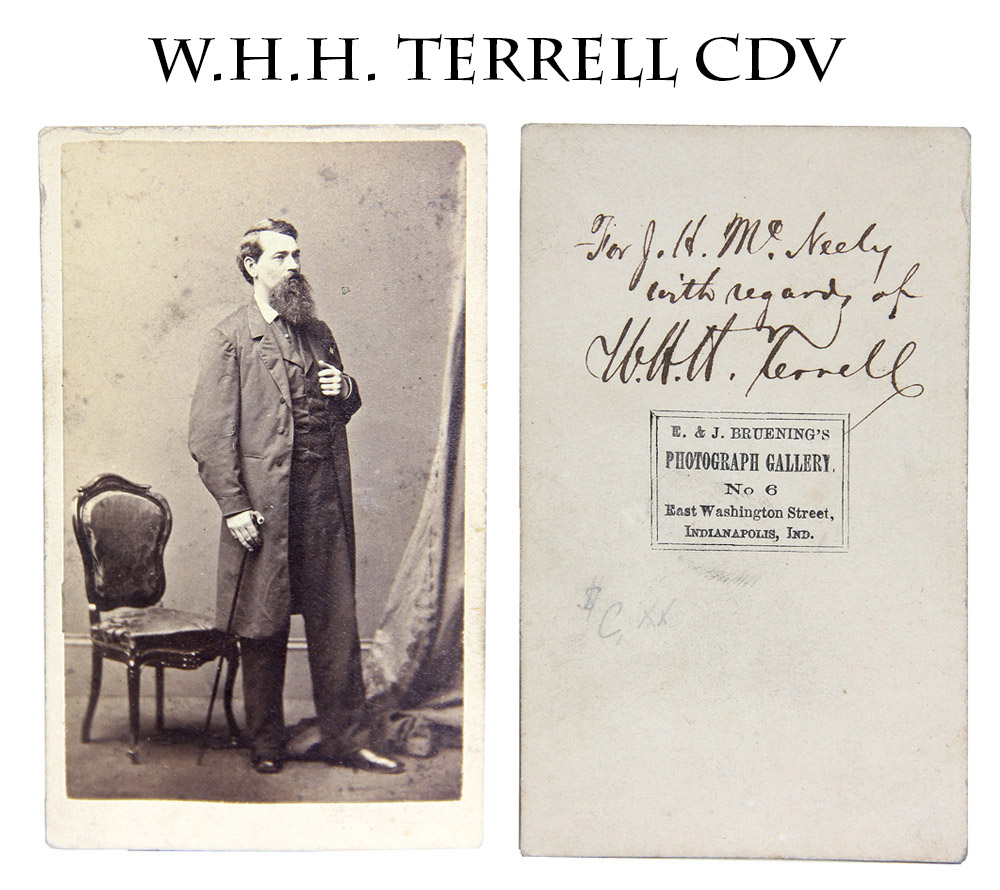
16-01-43 … INDIANA ADJUTANT GENERAL WILLIAM H.H. TERRELL … Very elegant pose, full standing, one hand grasping his lapel, the other holding a walking stick. Nicely signed in ink on reverse: “For J.H. McNeely with regards of W.H.H. Terrell.” Breunig, Indianapolis backmark. William Henry Harrison Terrell (1827-1884) was a former clerk, auditor, newspaper editor, lawyer and bank cashier, who was intimately involved with military affairs of the state. As a member of the Finance Department his correspondence included dealings with men such as John Wilder of the Lightning Brigade. He became the state’s Adjutant General in 1864 and served until 1869. He is best known as author of the eight volume set “Indiana in the War of the Rebellion,” a key resource for anyone interested in the state’s role in the war. In 1869 Grant appointed him as Third Assistant Postmaster General, a position he held for four years. An important figure in keeping one of the larger northern states in the fight. Historical Indiana Photo… autographed … $125.00
Call us @ 419-842-1863
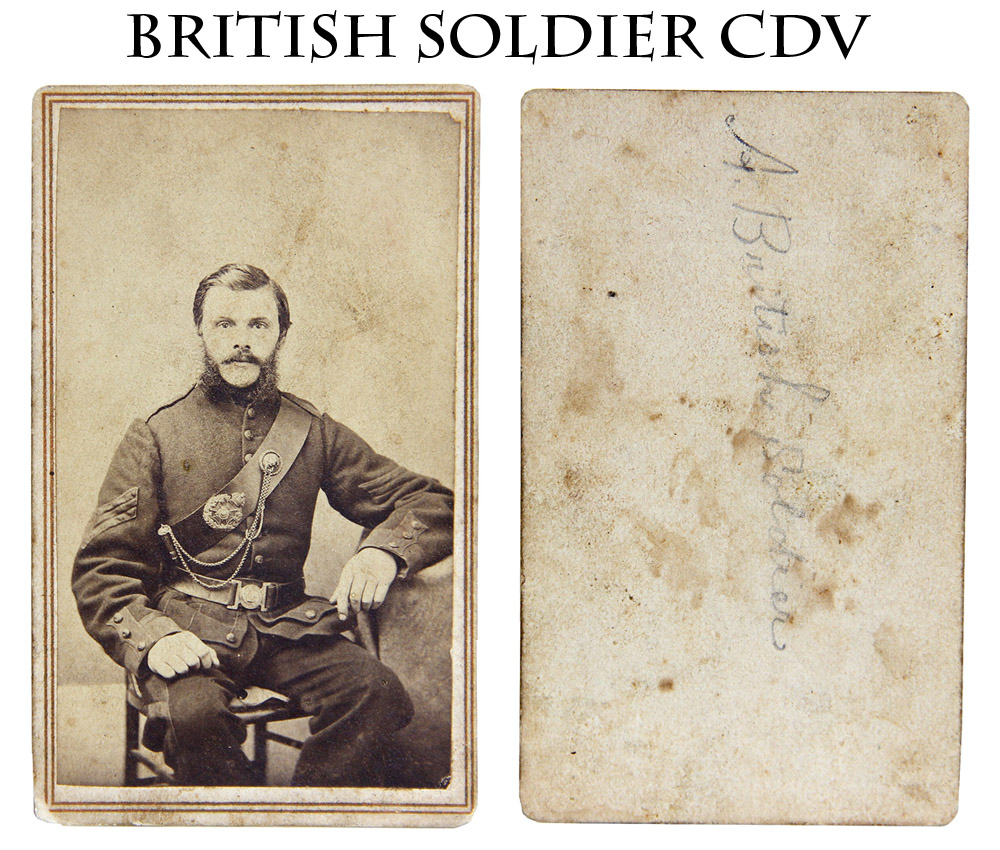
16-01-44 … “A BRITISH SOLDIER” … Three-quarter length seated CDV view of a British sergeant. No backmark, most likely a Canadian soldier. Period pencil on reverse: “A British Soldier.” Our man is nattily attired and wears a broad shoulder belt that features a whistle suspended by chains from a roundel with large badge in between that is likely a regimental insignia. Long side burns, mustache, hair slicked back, a likely candidate for one of Queen Victoria’s little wars, stalking up and down behind the firing line telling his men to “look to your front” and “mark your target.” After the Civil War he might have been one of those called face the Fenian raids launched by American Irish veterans across the border … $45.00 – SOLD
Call us @ 419-842-1863
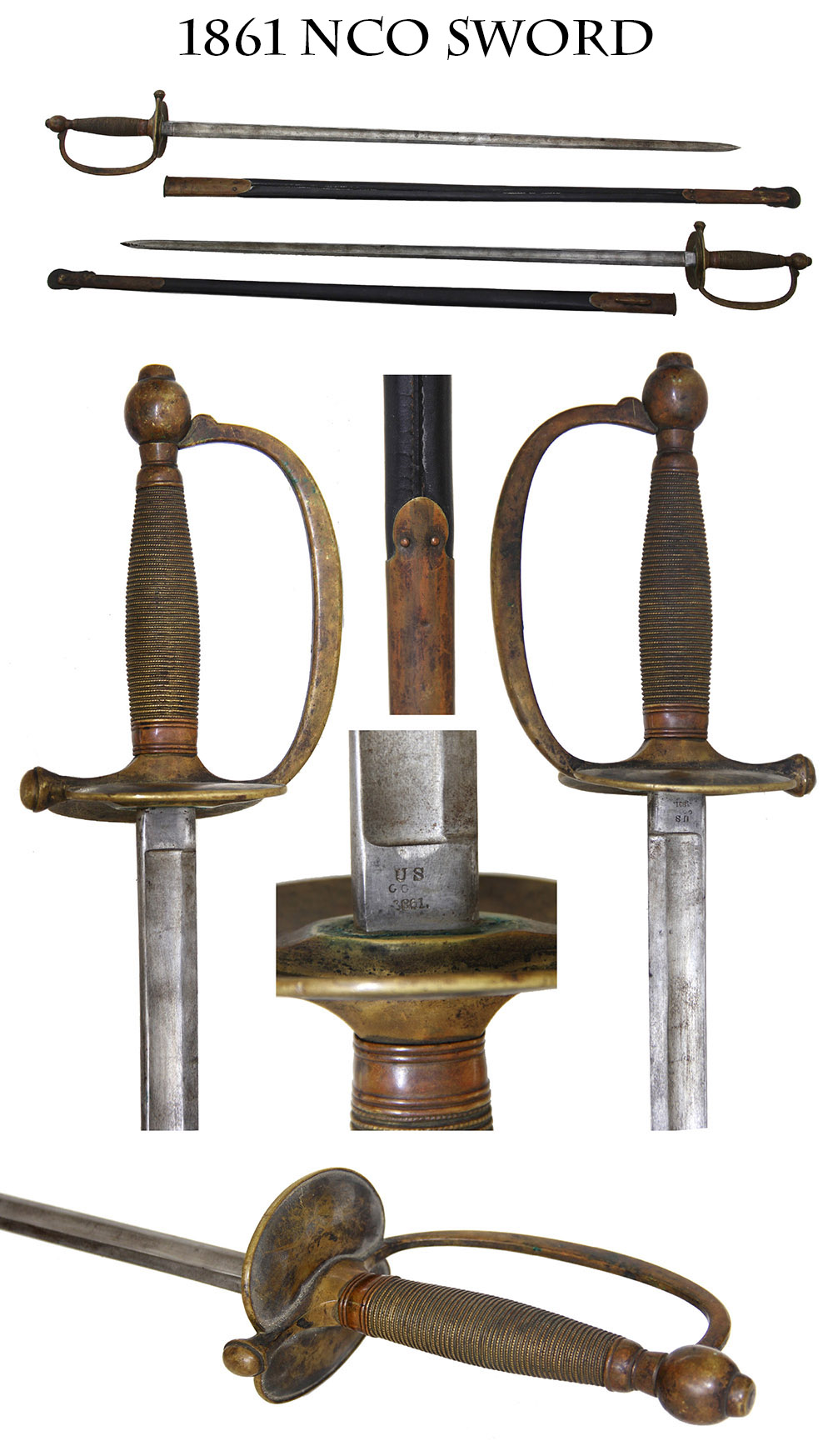
16-01-45 … 1861 DATED NCO SWORD WITH SUPERB LEATHER SCABBARD … The maker stamp on the ricasso is a bit light, but the sword is undoubtedly by Ames. The US and 1861 date are clear on the opposite side and the letters “GG” probably the first two initials of George G. Saunder’s “GGS” inspector’s mark. Brass hilt and mounts of the black leather scabbard have a matching patina. The scabbard body is solid, with no bends or breaks. One of the best I’ve found recently. The blade is good- silver and light gray, no nicks. These swords were carried by the five sergeants in an infantry company and members of the regimental noncommissioned staff. They were last ditch defensive weapons when carried in the field, but moreover served as icons of rank for NCOs who really ran things in the company. A regulation sword adopted in 1840 and regulation throughout the Civil War. Nice with the perfect scabbard and 1861 date … noco … $495.00 – SOLD
Call us @ 419-842-1863
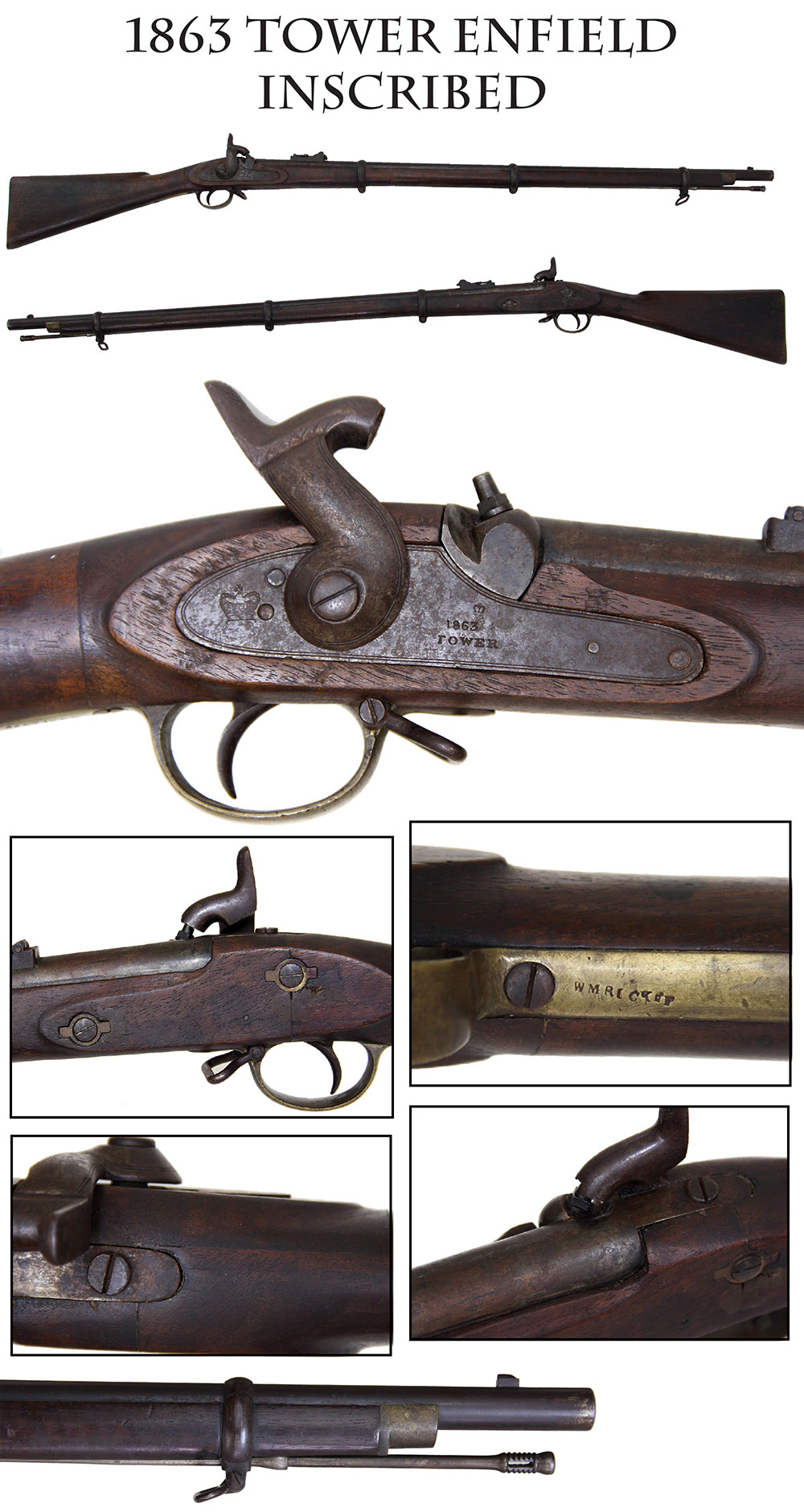
16-01-46 … 1863 DATED P-53 ENFIELD … the predominant import rifle musket during the war, north and south. This shows a superb repair to a damaged rifle. Someone with a lot of skill and time put this gun back together. It was broken through at the wrist and had damage to the underside of the forend. I don’t know who did the wood-work, but he could get a good job working for me any day. Look closely at the pictures to see the expert repairs. Just a hairline shows at the wrist, more noticeable on the right side from the wood color than the left. He also inlaid wood on either side of the ramrod channel. A name is stamped on the trigger guard tang that seems to be “WM R?CKFF”… undoubtedly misspelled by the stamper. (the second letter is from a broken die O or C or ?. The last two letters are not distinctly stamped but appear to be FF.) I can’t identify him as a soldier, though the stamping is IDENTICAL to soldier ID’s I have seen stamped on other Enfields. You might have better luck. The rifle retains both sights, all barrel bands and swivels. The nipple is good, not battered, and the action is good as well. The lock markings are clear. The barrel is completely unmarked: no view, proof, or bore designations. I have not removed it to examine the underside. The brass has a mellow patina, the wood has the aforementioned repairs but is otherwise fine, and visually excellent: the lock platform has very sharp edges. The ramrod is from a different rifle and should be replaced with a correct Enfield rod, but is an okay place-holder. The lock plate shows mostly gray with some brown spots overall. The barrel has a good amount of plum brown patina toward the breech. On the whole not a bad example and priced right, especially for the incredible wood work that went into it. And further research into the stamped name may prove most profitable … djj-maac … $675.00 – SOLD
Call us @ 419-842-1863
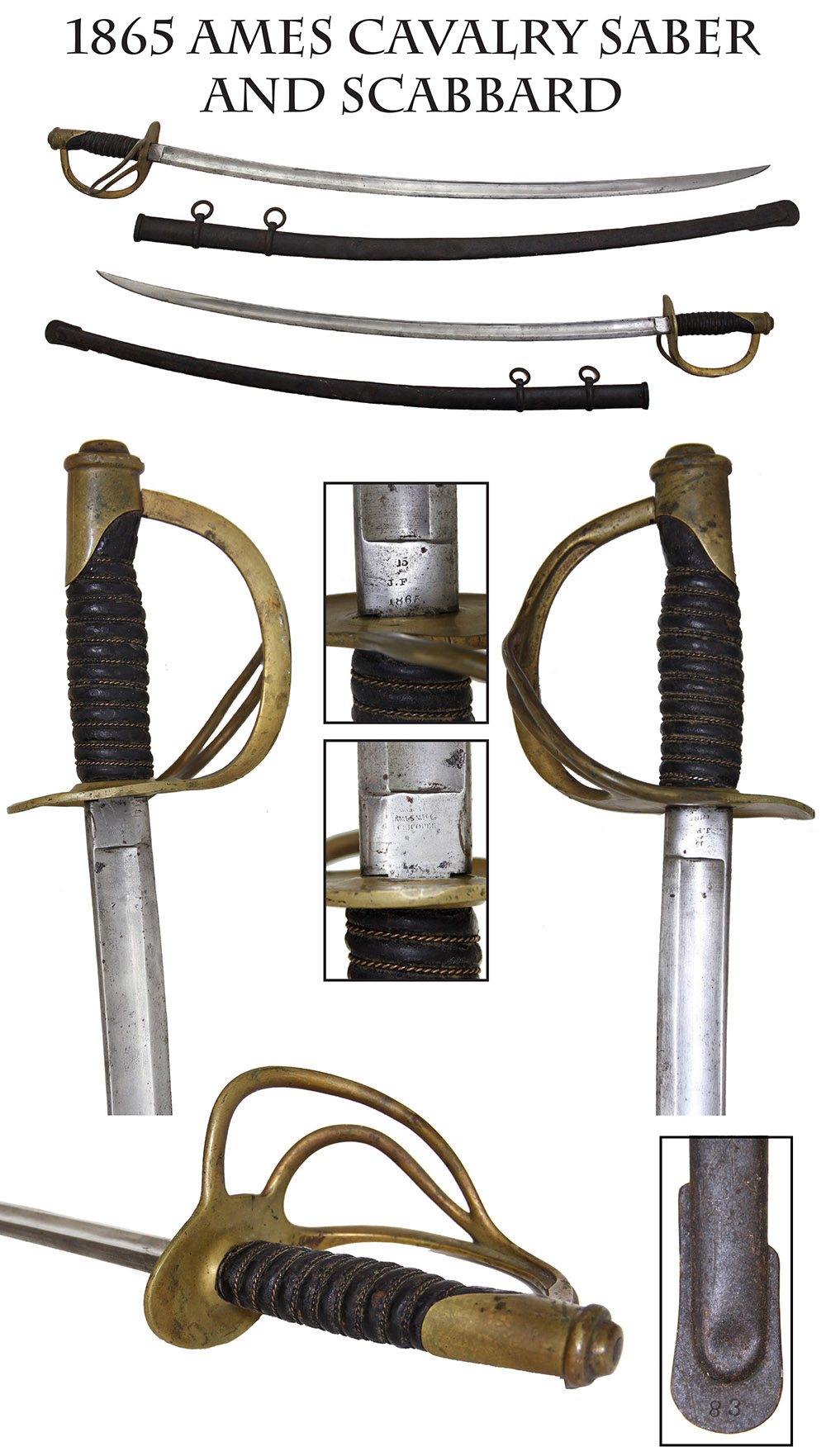
16-01-47 … 1865 DATED AMES LIGHT CAVALRY SABER … Good condition light cavalry saber by Ames. Light but legible Ames stamp at the ricasso with the US, date, and inspector stamp on the opposite side. Dull silver gray blade with some darker gray age spots, but a good edge and point. Grip has its original black leather wrap and original twisted brass binding wire. Nice mellow patina to the brass. Made in time for some of the large cavalry raids at the end of the war and also for the early Indian Wars on the plains, where cavalry played so large a part. Displays great. The scabbard with this is the 1906 pattern and I am knocking the price down accordingly. Many Civil War cavalry sabers were brought out of storage, cleaned and updated for issue when the army revived the 1860 style after the turn of the 20th century. The key point for the collector is to pay attention to the spacing of the carrying rings. Affordably priced at … cjj … $425.00
Call us @ 419-842-1863
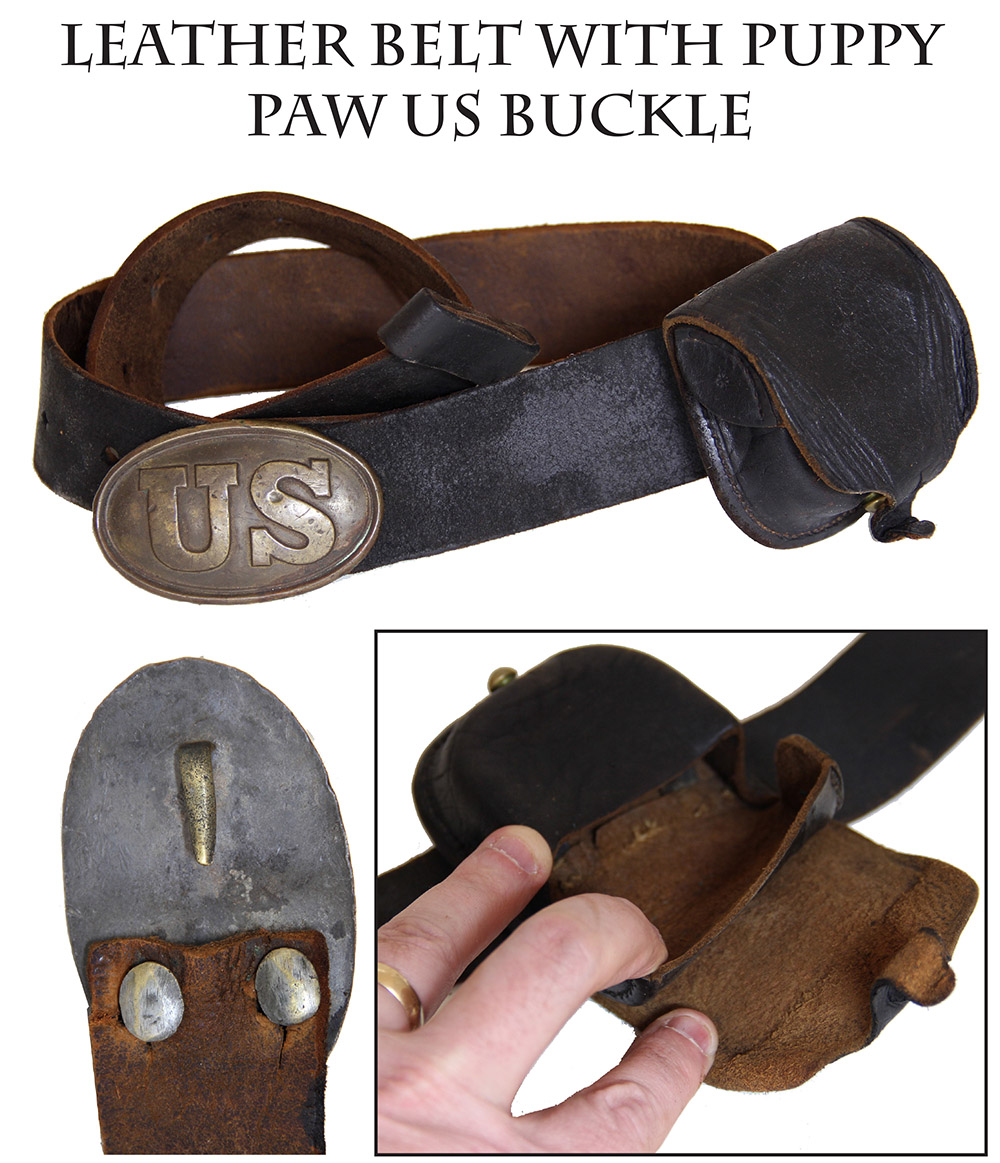
16-01-48 … EARLY WAR INFANTRY BELT RIG WITH STANDING LOOP ADJUSTER PUPPY PAW BUCKLE AND CAP BOX … Early war infantry belts followed the prewar pattern of having a standing loop leather adjuster on one end of the belt to keep the loose end from flopping down below the waist. This proved to be unpopular with the men, who sometimes had difficulty feeding the belt through a loop shrunken by exposure to the elements, and sometimes remedied the situation by cutting the end off, which later led to the use of brass C-clasp keepers on the belt tip. These early war leather loop patterns are tough to find. This one has a nice early war stud-back (or puppy-paw) oval US plate on it, which has been on it “forever” judging by how well the leather is molded to it. The belt retains about all of its blacking, and there is a matching cap pouch on it: one-piece cover with intact belt loops, inner cover and side ears, no fleece, and overall very good finish with just some flexing marks at the corners showing a soldier actually used it. The US plate has a delicate age patina- a few minor dings just enough to show it was worn in the field. A very solid Yankee foot-soldier’s belt rig in very good condition. Some of the tourist town dealers price the stud-back US buckles near this price. A great deal at … dej … $495.00 – SOLD
Call us @ 419-842-1863

16-01-49 … CONFEDERATE 1860 DATED AMES LIGHT CAVALRY SABER WITHOUT US INSPECTOR MARKS … Ames contracted with the US government for 5,000 cavalry sabers in 1859 and they were delivered over the next year, some dated 1859 and some dated 1860. Secretary of War John B. Floyd, a Virginian, diverted 1,200 of these swords, made between May and September, 1860, to the state arsenal in Virginia, from whence they made their way into the hands of Confederate cavalry. Floyd directed Ames to have the swords inspected, but is suspected these uninspected 1860-dated blades may have been among the earliest of the 1,200 and were sent out before Ames received that directive. In addition the Mass Arms Company supplied Virginia with Adams revolvers and 1000 Ames sabers in 1860. These too have no US marks or inspector’s initials. These uninspected 1860 dated sabers have always had a strong Confederate connection in the colletor’s market, and you can be assured they saw service in the hands of Virginia Confederate cavalrymen. Ours certainly shows the hard use characteristic of Confederate weapons in general. The blade is dark brown and gray with scattered spots of brown coming up from beneath and some scattered pitting at the ricasso. Some of the lower two lines of the Ames block letter stamp at the ricasso can be made out and on the other side the 1860 date is clear, and there is no US or inspector’s mark. The leather pad is still in place at the blade shoulder. The leather grip wrap is entirely gone and just a few coils of the twisted brass binding wire remain. Aged patina to the brass. It might be tempting to restore it, but I would leave this as is- a scarce version of the Ames Virginia delivered 1860, an interesting study piece, and a saber with strong Confederate associations … ij … $795.00 – SOLD
Call us @ 419-842-1863

16-01-50 … MODEL 1913 CAVALRY SABER … The “Patton” saber, developed by George S. Patton, adopted at the time of the Mexican Border Campaign and just before the outbreak of World War One. The last of the US cavalry sabers. Long, straight bladed, double edged. Hefty enough to deliver a cut, but actually a thrusting weapon and long enough to reach a man prone on the ground. The last of the regulation US cavalry sabers. Not intended to be worn on the person, but carried on the saddle. Silver gray blade with a smattering of darker age gray. Very good edge and point with no nicks or chips. Blackened sheet metal cup guard and grip, green canvas covered scabbard with blackened mounts. The scabbard shows a soldier’s painted rack number and company letter, indicating the sword was actually issued and carried. Clear “L.F. & C.” (Landers, Frary and Clark) maker’s stamp with 1918 date. An impressive sword and a key piece in a collection of American swords or cavalry weapons. A mountain of bang for your buck … bjj-mil … $395.00 – SOLD
Call us @ 419-842-1863

16-01-51 … CDV PHOTO MUSICIAN WITH ROTARY VALVE HORN … Cornet bands were all the rage in the 1870s. Our man poses with an early rotary valve instrument tucked into the crook of his arm in this studio shot. McHenry, Freeport, Illinois backmark. Takes you back to the days of Sunday afternoon concerts on the village green … noco … $25.00 – SOLD
Call us @ 419-842-1863

16-01-52 … SMITH CARBINE … Super Smith Carbine loaded with barrel blue, case colors on the frame (vivid on the left, faded on the right) and nice blue on the band between the buttstock and receiver as well (usually the first spot to go). Vivid blue on the latch and sight. Matching serial number 9394 on frame and barrel. Crisp wood with good fit to the metal. Very strong “JH” cartouche on the left side that you can see across the room. Both sights in place, as well as saddle ring and bar. Crisp patent stamps and Poultney and Trimble agent stamp on the left frame. American Machine Works manufacturer stamp under the side bar. Excellent bore. About 30,000 of these were made by three different manufacturers and almost the entire production run was purchased by the government. Crisp action, super bore. A very pretty gun. Used by the 1st Connecticut, 7th Pennsylvania, 6th Ohio, and other cavalry units. This carbine is a real “show-off” and deserves a place in a good martial arms or cavalry collection. NRA extra fine to excellent condition … aajj-150728 … $2,250.00 – SOLD
Call us @ 419-842-1863
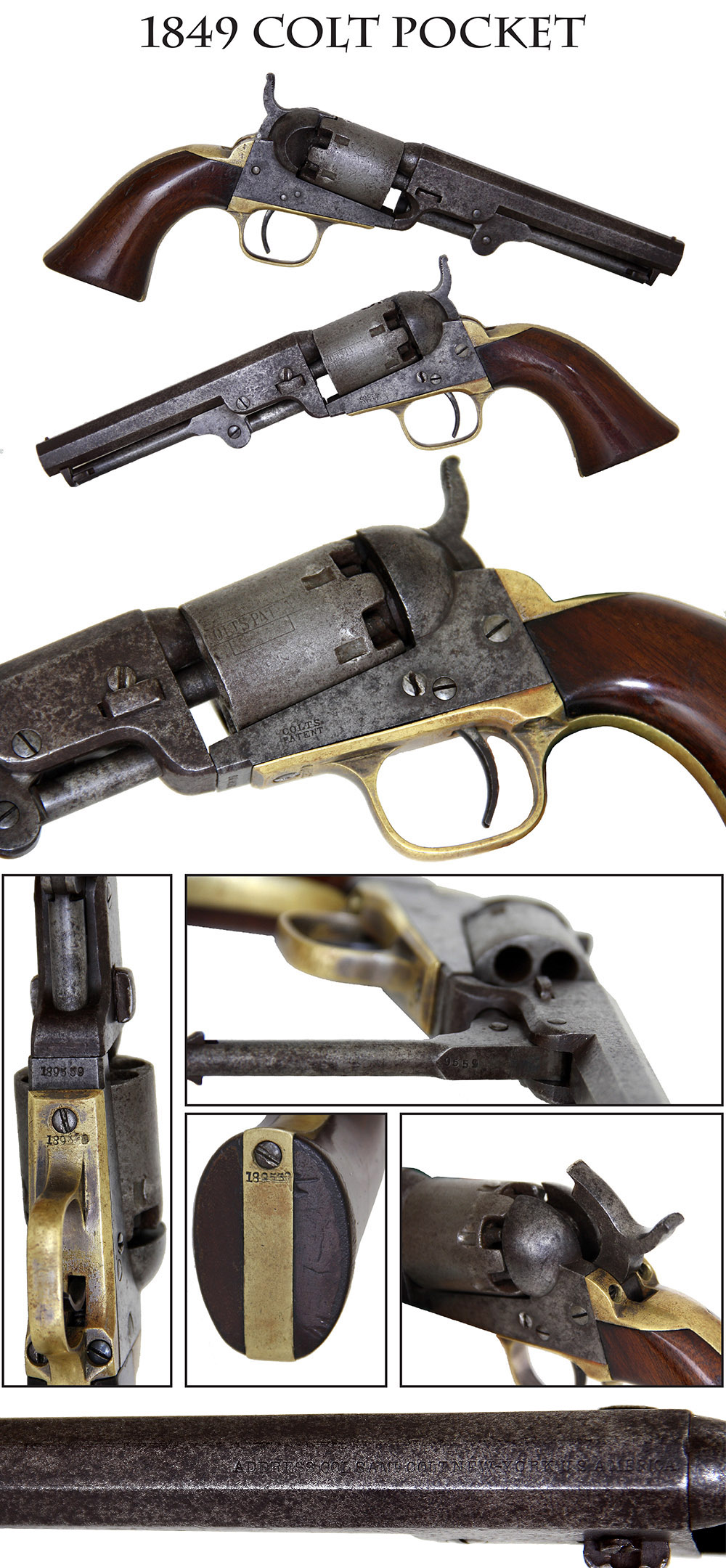
16-01-53 … 1849 COLT POCKET … Classic colt 5 inch pocket pistol, serial number 189559 on the frame, giving an 1861 date of manufacture, matching “9559” on the loading assembly. Very typical of side-arms purchased by officers during the Civil War who were not about to have a large frame .44 revolver weighing down their waist belts on a long march. Gray mixed with brown spots overall but with no pitting, clear Colts Patent marks and a partially visible cylinder scene to boot. No serial visible on cylinder. Walnut grips are a good tight fit and has just a couple of small dings on the bottom of the butt. For some reason the barrel serial number has been removed and the last three digits of the numbers on the trigger guard tang and butt strap are largely obliterated, but they start with the same “189”. Reason … ??? Your guess is as good as any. Mechanically good. A good solid example of a popular sidearm priced right … cej-17193 … $495.00 – SOLD
Call us @ 419-842-1863

16-01-54 … MODEL 1858 SMOOTH SIDED CANTEEN … Nice condition regulation Civil War canteen complete with cover and strap. The key accoutrement for any soldier, along with his haversack. You don’t march far without water and food. This one in good condition and was actually issued and carried by a soldier- his rack number “33” or “53” is partly visible on one side. Brown wool cover with expected stains and dirt, but no mothing, tears, threadbare spots or open seams. Sling is complete and original. Knotted about half way along, a little weak at the bracket edges, the usual spots for wear. Missing the stopper and string cord, but you can find one if you shop eBay or attend the shows. A very nice example … zbejx … $365.00 – SOLD
Call us @ 419-842-1863

16-01-55 … DAVY & COMPANY LARGE SIZE PISTOL CARTRIDGE BOX … Regulation issue cavalry pistol cartridge box. A basic US cavalry accoutrement. Black leather, two belt loops, cover fastened by a latch tab over a brass finial. Interior is fitted with two leather dividers that hold the cartridge packs in place by friction. Nice “J. Davy & Co./ Newark NJ” marking on the lower front flap. Some crazing, minor finish loss and a little verdigris that should be wiped off the rivets. A key piece of cavalry gear issued to every trooper to keep his .44 and .36 caliber revolver ammunition separate from his carbine ammunition, and well marked by a known government contractor. This is the largest size pistol box… the one we used to refer to as the 44 caliber. Overall VG condition … adj-14646 … $235.00 – SOLD
Call us @ 419-842-1863


16-01-56 … CONFEDERATE BUTTONS FOUND AT JOHNSON’S ISLAND … One of the major US prisoner of war camps for Confederates, located near Sandusky, Ohio, on Lake Erie, was Johnson’s Island. The prison opened in 1862 and held about 15,000 prisoners over the course of the war. The prison was notable largely for its relatively low mortality rate. Early in the war prisoners enjoyed visits from towns folk and were allowed to sell locals all sorts of carved works of art. Later in the war when news reached Ohio of the state of affairs at Andersonville, the Ohio POW camp retaliated by limiting blanket distribution during cold periods and eliminating visits from towns folk, and all other forms of comfort. The site was abandoned after the war and since then has yielded CS souvenirs to relic hunters from the 1800s to the present day. These two buttons came out in the mid to late 20th century and I got them recently from a Cleveland area collector. One is a “Confederate local” Georgia button with a plain back, depressed channel and no maker mark, shank in place but bent over. Some corrosion, but shows more detail than many locals: the banners wrapped around the columns are plainly visible as is the figure inside on the left, who is a militia man standing guard. The second is a nice CS General Staff button back marked “H.T. & B., Manchester” retains a lot of its original gilt (Albert CS36; Tice CS210A1.) The Georgia is a bit indistinct on its face, but the eagle and stars rates excellent with just the expected wear on its high points. Prisoners often used buttons as trade goods with locals and guards anxious for a souvenir. These plainly show they escaped that fate, but were lost on the prison grounds by some comparatively lucky Johnny Rebs. Priced well below the button specialists. Both for … $795.00 – SOLD
Call us @ 419-842-1863
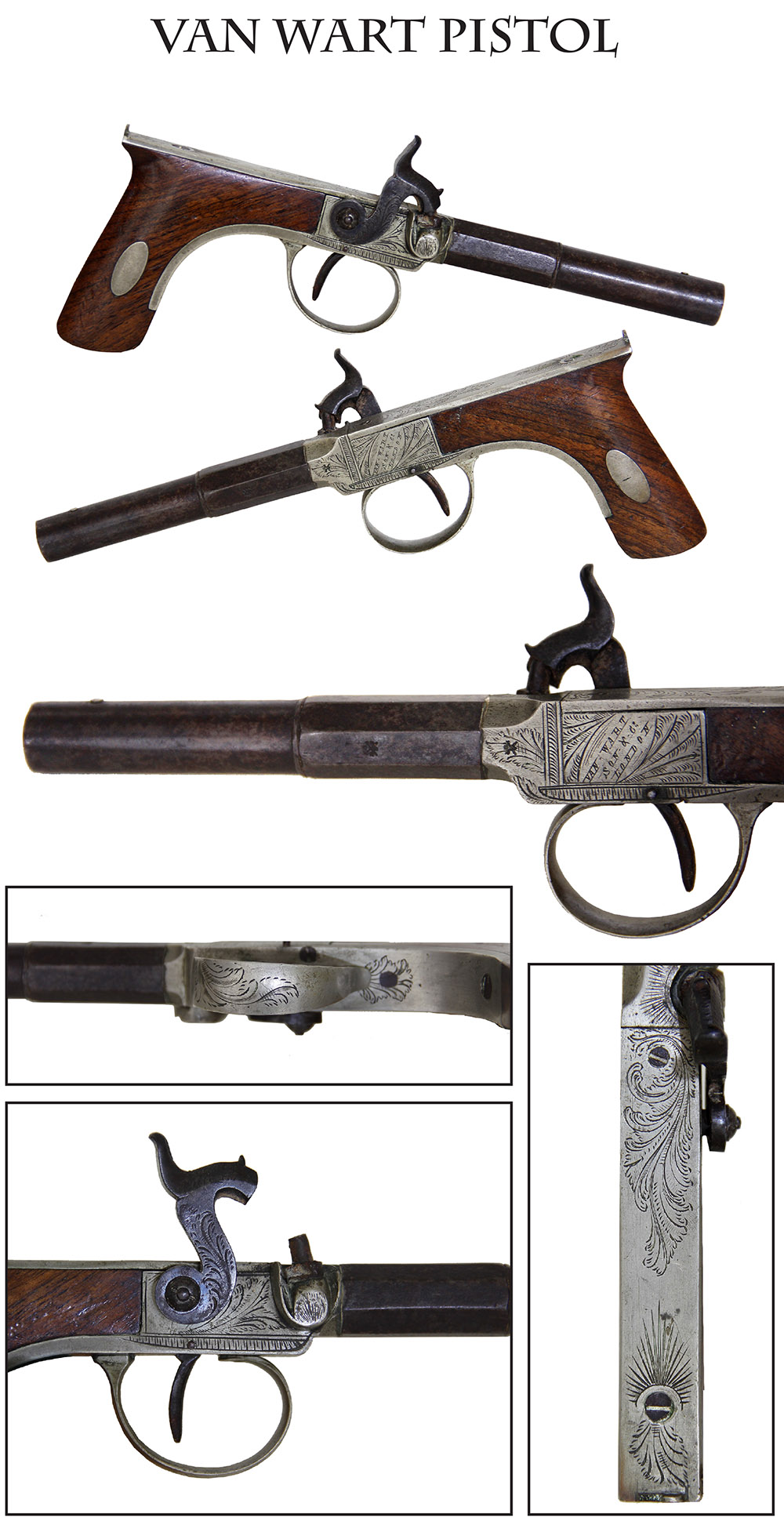
16-01-57 … Beautiful Southern Flavor Saw-Handle Pistol signed Van Wart: A superb saw handle, silver mounted, percussion pistol. Roughly 9 inches overall length. Barrel 4 inches. 36 caliber. NRA near fine condition. Henry Van Wart (1784 – 1873), was an American businessman who became a British citizen by special act of Parliament, He founded the Birmingham Stock Exchange and had four children: William (1812 – 1868), Matilda (b. 1814), Marianne (b. 1816). and George (b. 1817). He set up a profitable business in Birmingham exporting the city’s goods to America … and largely to the south. Van Wart was friends with Louisiana businessman Frederick W. Tilton, who became Van Wart’s agent in New Orleans. He sold thousands of buttons to the Confederacy (see illustration of one above). The buttons were intended to come south through the blockade, but it is uncertain if any arrived before the end of the war. This strikingly handsome pistol also bears his firm name. Likely sent to New Orleans or Charleston just prior to the Civil War … $1,150.00 – SOLD
Call us @ 419-842-1863
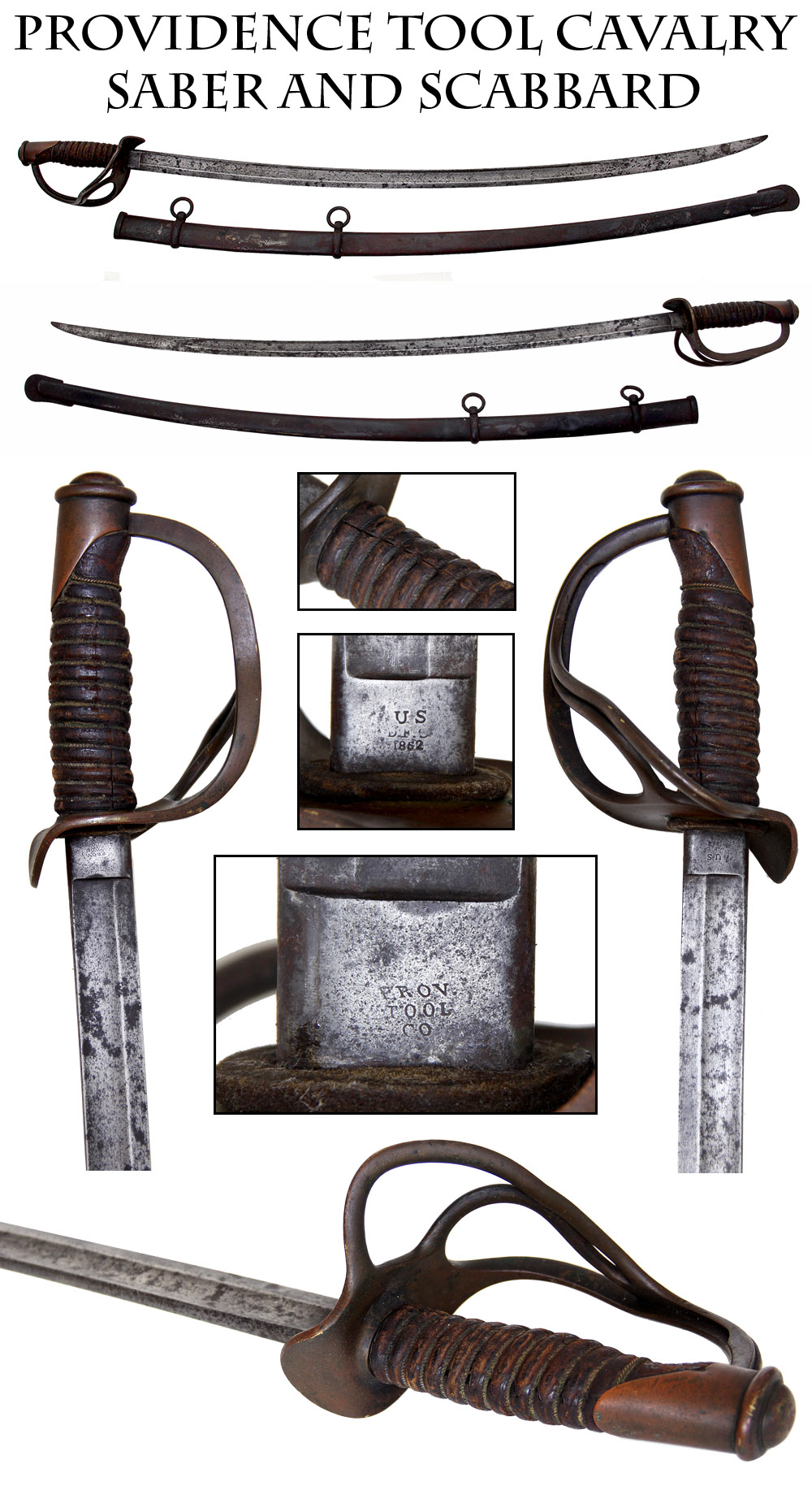
16-01-58 … PROVIDENCE TOOL COMPANY SABER AND SCABBARD WITH 1862 DATE … One of the scarcer contract sabers to find … A nice early war 1862 date is clearly stamped on the ricasso of this 1860 light cavalry saber, along with “Prov. / Tool / Co” on the other side. Above the 1862 date is a US acceptance mark and the stamp of a previously unknown inspector “DFC” (Thillmann lists only “RPB” and “JM.”) The grip has all the leather covering but only one strand of the twisted binding wire. The brass has a mellow tone and the quillon is bent forward showing proof positive that it was issued and carried in the service. The leather pad is still in place on the blade shoulder, and the blade still has a good edge and point. The blade shows gray overall with scattered dark spots distributed evenly over its length. The scabbard is complete with throat, rings and drag, showing brown/ muted plum color with some crusty raised rust near the bands that will clean. There is some light gray between the bands from rubbing. Not mint by any means, but solid and handsome, and a real veteran with an early date and a scarce marking. The Providence tool company produced both rifles and sabers. Their 1862 contracts for enlisted cavalry sabers totaled only 5,000, and very few of those survive. These are among the scarcest of the contract light cavalry sabers … $595.00 – SOLD
Call us @ 419-842-1863

16-01-59 … SUPER CONDITION SMITH AND WESSON … Exceptional example of the Smith and Wesson Number 2 Army revolver. These are about the most technologically advanced revolvers of the period and when they retain their factory finish like this one they are gorgeous. About 90 percent or better blue on the barrel and frame, a little lighter but evenly worn on the cylinder. Where the finish thins out it does it so gradually and evenly that the eye glides along it and it is not at all offensive. The only wart is some marring on the left side of the frame around the screw head. Just about perfect dark brown rosewood grips with super color and finish. Serial number 24182, a good mid-war number. Wartime production extends into the 35000 range. Mechanically excellent. A superior example of the popular .32 rimfire revolver. Its light weight and resilient ammunition made it a favorite with Civil War officers and early westerners alike: Custer and Wild Bill Hickock, to name just two famous figures, owned them. It will be hard to find another in this condition for anywhere close to this price. I found it at OGCA two weeks ago for two thousand dollars and snatched it up. You may have it for … bjjj-zxw … $2,350.00 – SOLD
Call us @ 419-842-1863
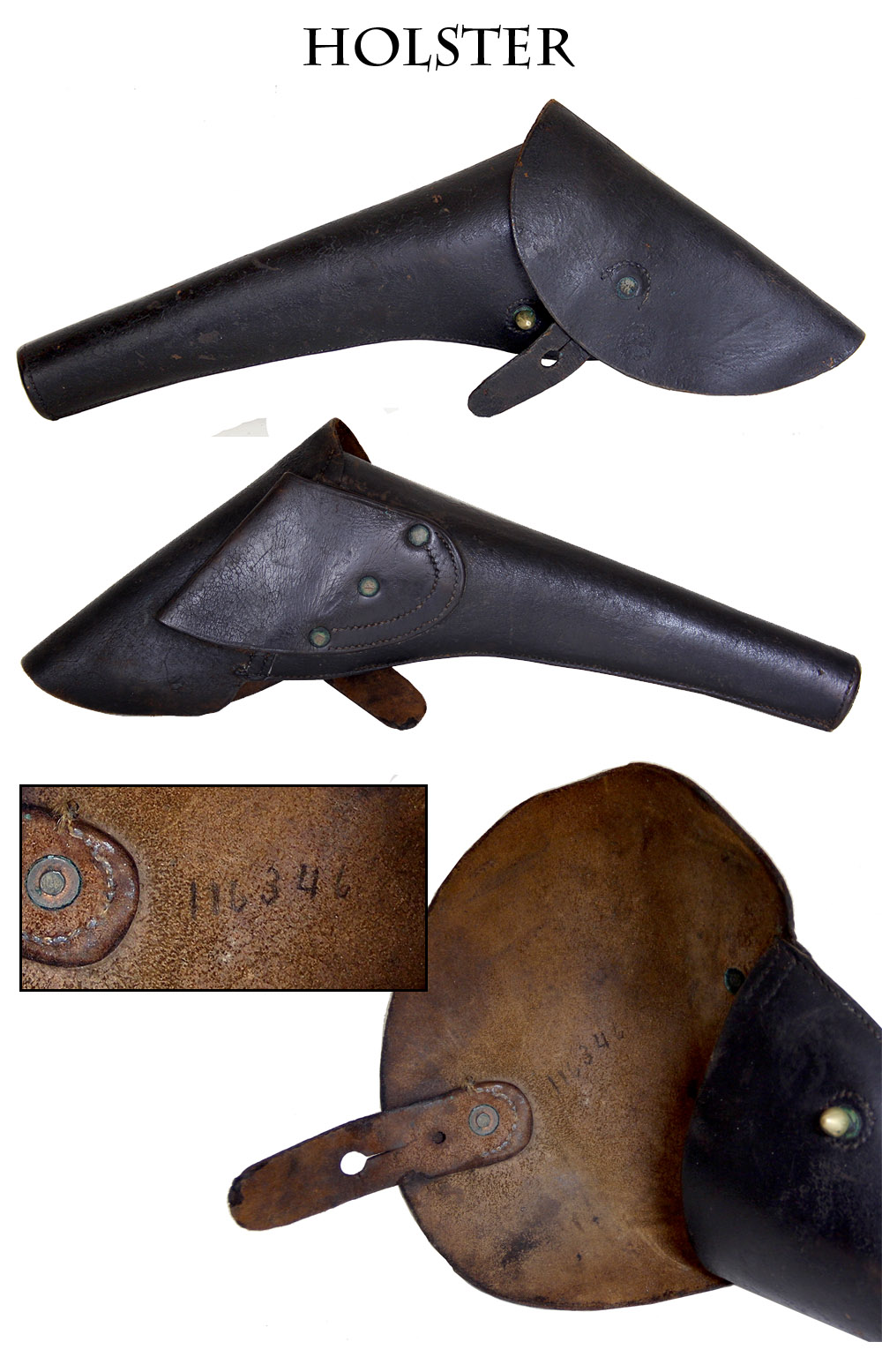
16-01-60 … SUPERB CIVIL WAR CAVALRY HOLSTER FOR COLT OR REMINGTON ARMY OR NAVY REVOLVER … Top-notch condition classic Civil War cavalryman’s revolver holster. Black leather with a flap secured by a sewn and riveted latch tab. Toe plug in place. Belt loop in place, secure and not torn up at the corners as many are. Super finish, just a couple of light abrasion spots and some of the usual crazing or wrinkle lines. On the underside of the flap is a six digit number in ink which I am betting is the serial number of the gun that resided here long long ago. No maker’s marks so likely an early war item. A very fine condition holster like we used to see in the old days. Those offered now are usually more akin to wet rags. No need to upgrade this one with your belt set or pistol. A great example priced realistically. One of the best I have seen in recent months. Fresh from OGCA show … eej-pet … $695.00 – SOLD
Call us @ 419-842-1863
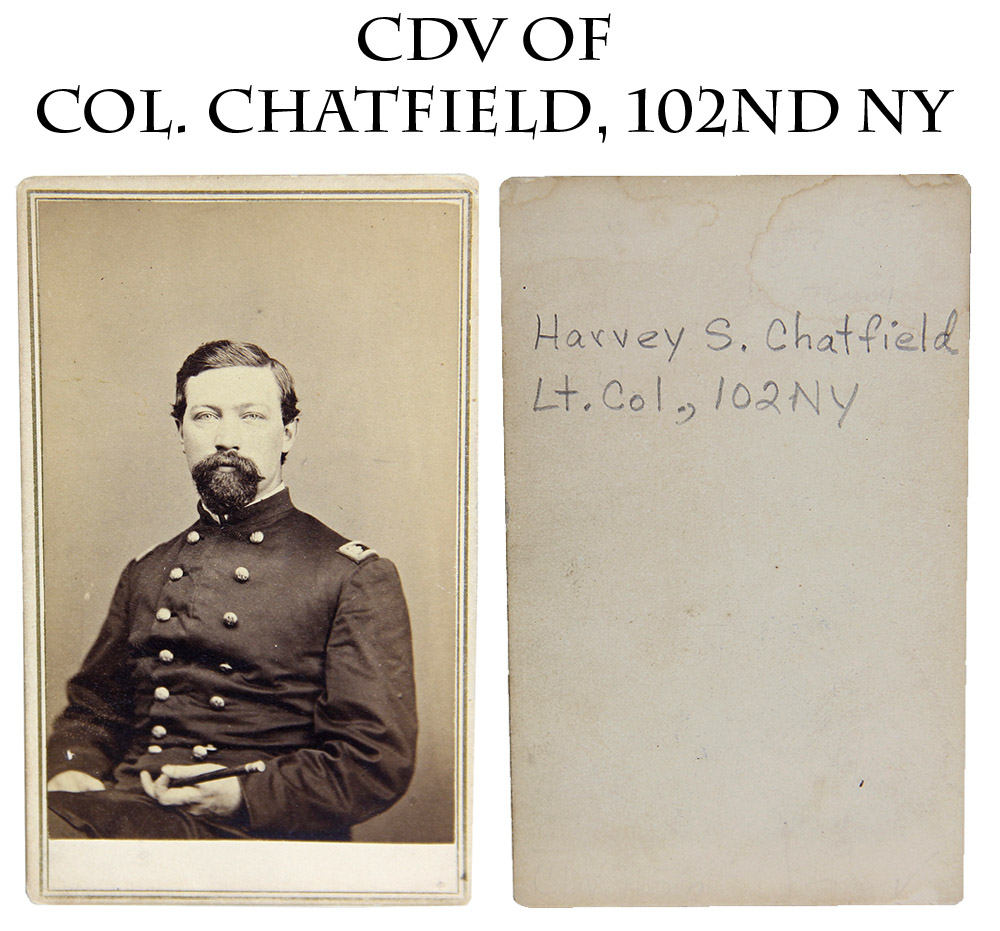
16-01-61 … CDV OF COL. CHATFIELD … 102nd NY Harvey Strong Chatfield certainly knew how to pose for a photo. A lawyer by profession, he signed up as a private in the 7th New York in April, 1861, and served with that early war unit as it rushed to Washington to save the nation’s capital. In August, 1861, he mustered in as a captain in the 43rd NY and served about a year until he resigned and entered the 78th NY in August, 1862, rising to lieutenant colonel of that outfit in November, 1863. He moved over to the 102nd NY in July, 1864, and became colonel of the regiment in January, 1865. He mustered out July 21, 1865. Very crisp half-length seated view of Chatfield in a field grade officer’s coat with his Lt. Col. straps showing and holding a swagger stick or riding crop. Well groomed and poised, he looks like he is used to command. Identification on the reverse in the hand of Roger Hunt (whom any photo collector should recognize) and the pose also appears in Roger’s New York volume of Colonels in Blue … hj-pp-rosa … $145.00 – SOLD
Call us @ 419-842-1863

16-01-62 … JOHN KELLOGG AND HIS 1855 HARPERS FERRY 2-BAND RIFLE … A sharp seated view of a man in civilian clothes seated in a studio showing off the ultra rare 1855 Harpers Ferry 2-band rifle for the camera. The civilian clothes and lack of a tax stamp indicate we are probably looking at an early war volunteer displaying his patriotic intentions, even if he has not yet been issued a uniform. Brooklyn, NY, backmark with a period ink inscription “John Kellogg.” Above that a collector has noted “Co. H, 27th NY Inf.” This may be correct, but I don’t see any prima facie evidence to narrow down the identification among the numerous John Kellogg’s from NY, and the 27th NY was an early war, but a mid-state regiment. In any case, this is a great photo displaying that early-war hunger to get to the front that jaded veterans later recalled with amusement, and it’s a great period shot of an 1855 Harpers Ferry rifle, one of the rarest guns to find today, and one almost never seen in CW photos, largely because the Rebs captured most of them in 1861 and used them until they were all used up. Great CW photo … with 1855 rifle … noco … $375.00 – SOLD
Call us @ 419-842-1863
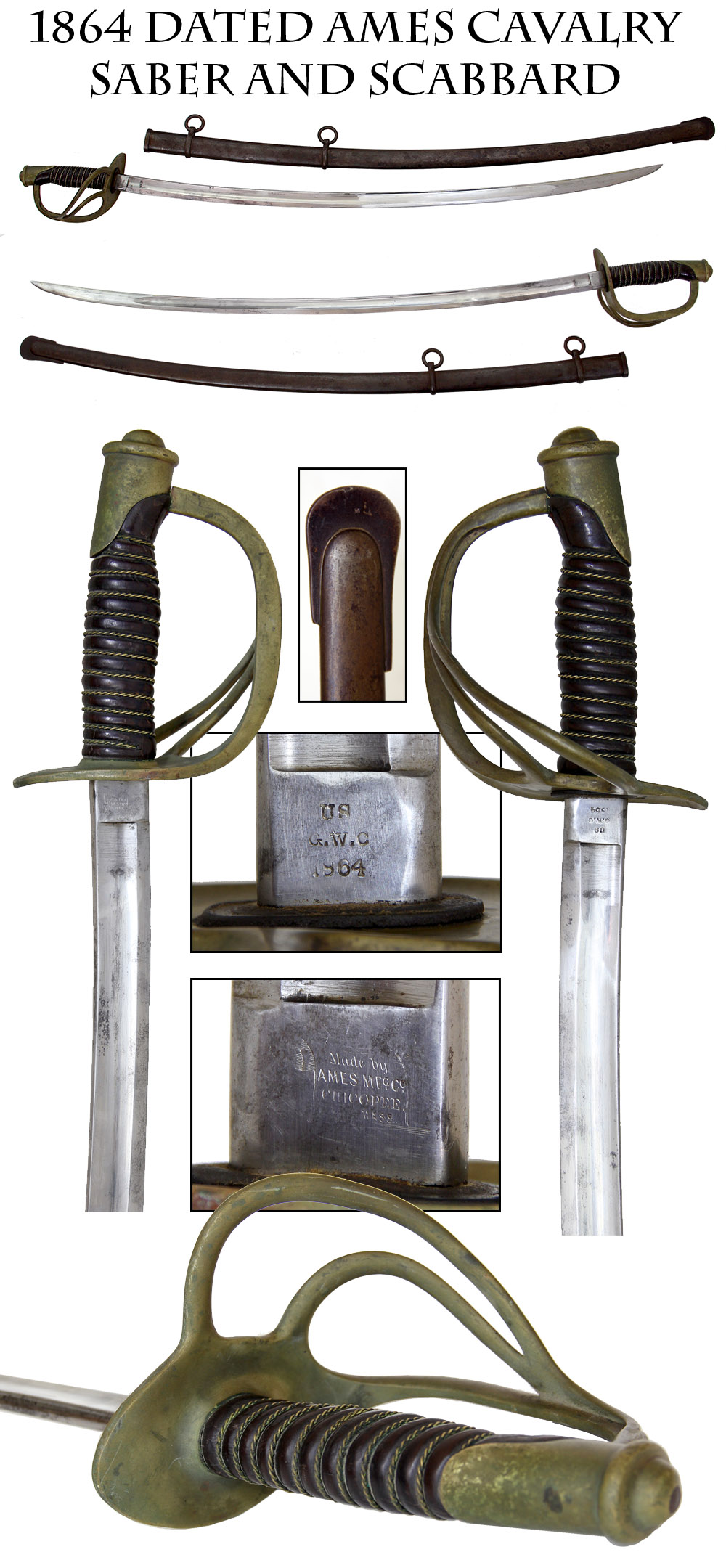
16-01-63 … EXCEPTIONAL AMES 1864 DATED LIGHT CAVALRY SABER … Civil War enlisted cavalry sabers don’t get much nicer than this. Blade in the bright with just the faintest of light gray cloud showing up near the hilt. Crisp Ames manufacturing stamp in the scroll style on the ricasso, with a sharp US/GWC/1864 stamp on the opposite side. Full original leather wrap and wire binding, excellent on all fronts. Leather washer in place. Good undamaged edge and point to the blade. Untouched patina to the brass. Scabbard with original nice even brown patina, rings, throat, and drag in place … Even some old grease in nooks and crannies. Nicely dated to 1864 when the Federal cavalry really came into its own. An exceptional specimen that would be hard to upgrade and one that looks great in an edged weapons or cavalry display. Darn nice example … super blade … g … $875.00 – SOLD
Call us @ 419-842-1863
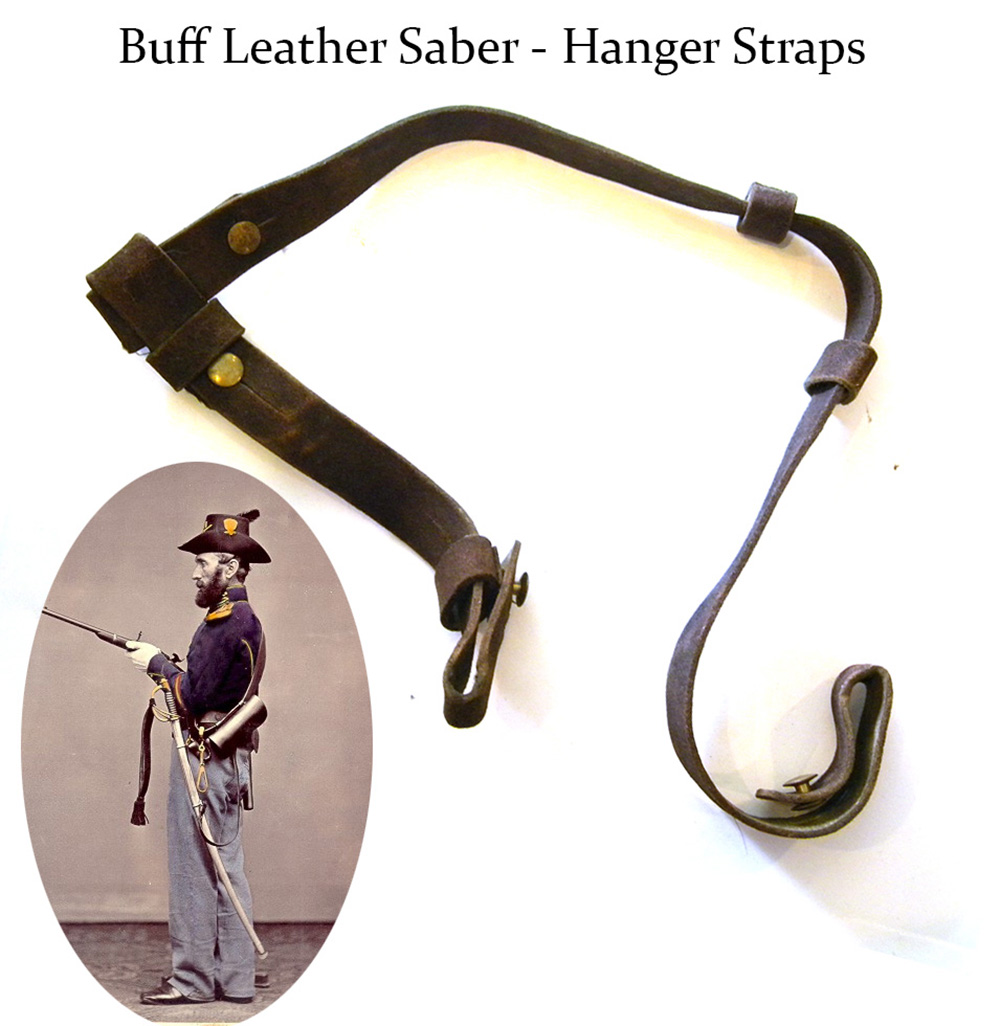
16-01-64 … ORIGINAL BUFF LEATHER SABER HANGER STRAPS FOR CAVALRY SABER BELT: Here is something that NEVER turns up, both the long and the short saber hanger straps for the enlisted cavalry saber belt. These are near perfect condition and complete with all four of the sliding loop adjusters and all four brass buttons. The last set of these we had was in 2013. They were missing the sliding loops and were snatched up at $495.00 lickity split, with numerous backup requests. We frequently find the buff belts with eagle buckles missing the saber hanger straps. Well … here is your opportunity to buy the original straps to restore your belt. Excellent – near mint condition. Still pliable… good color… no damage … Shown fastened together … $495.00
Call us @ 419-842-1863
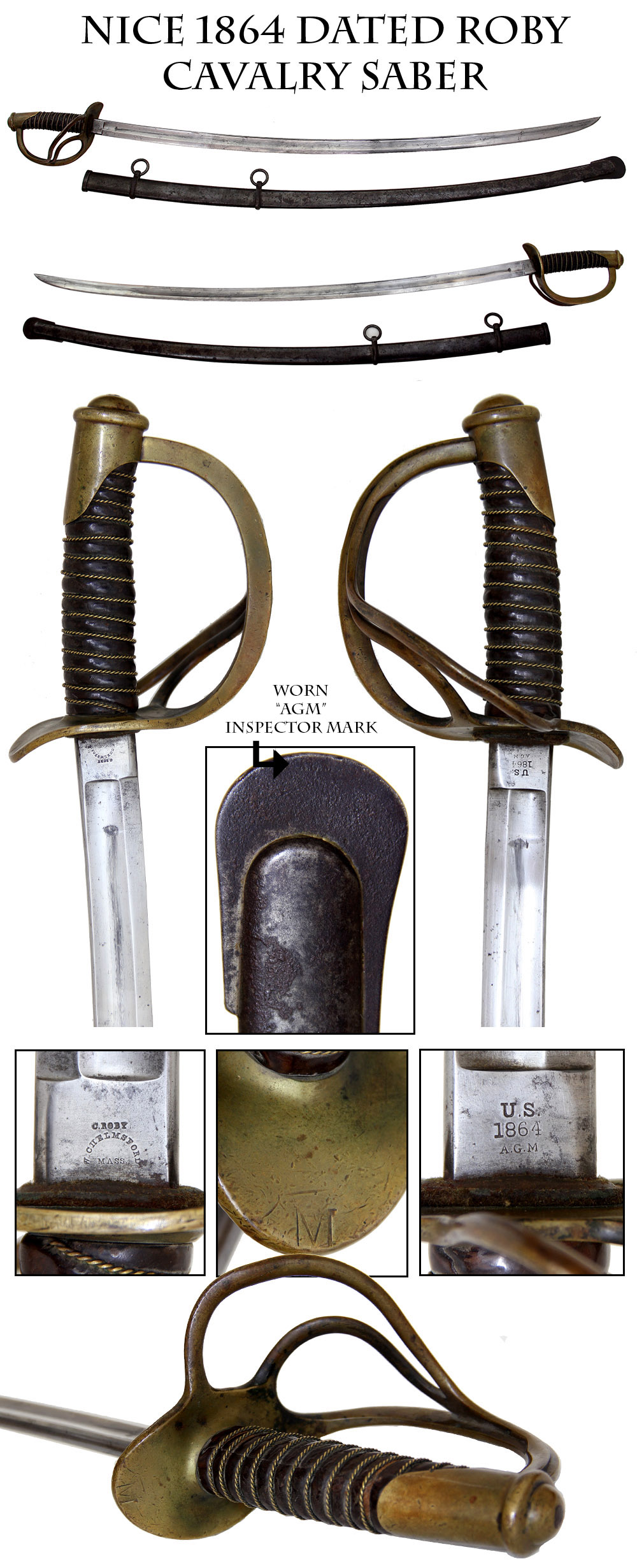
16-01-65 … 1864 DATED ROBY LIGHT CAVALRY SABER … Roby is the most readily identifiable maker of Civil War cavalry sabers behind Ames, and their products were in no way inferior. This one has a nice crisp Roby, Chelmsford, Mass., maker’s mark on one side of the ricasso and a sharp US/1864/AGM mark on the other. The scabbard also shows an AGM inspector mark on the toe of the drag, a good indicator the saber and scabbard have been together forever. Untouched patina to the brass hilt. Nice leather on the grip. Full wire, slightly loose. Blade in the bright with just some scattered light gray clouding. Good undamaged edge and point. Scabbard shows gray with some brown crust. This could be cleaned, but is good as is. The sword was actually issued. There is a company letter “M” neatly stamped on the inside of the guard at the upper edge. A good looking, regulation Civil War Yankee trooper’s saber in superior condition … fjj-veg … $750.00 – SOLD
Call us @ 419-842-1863
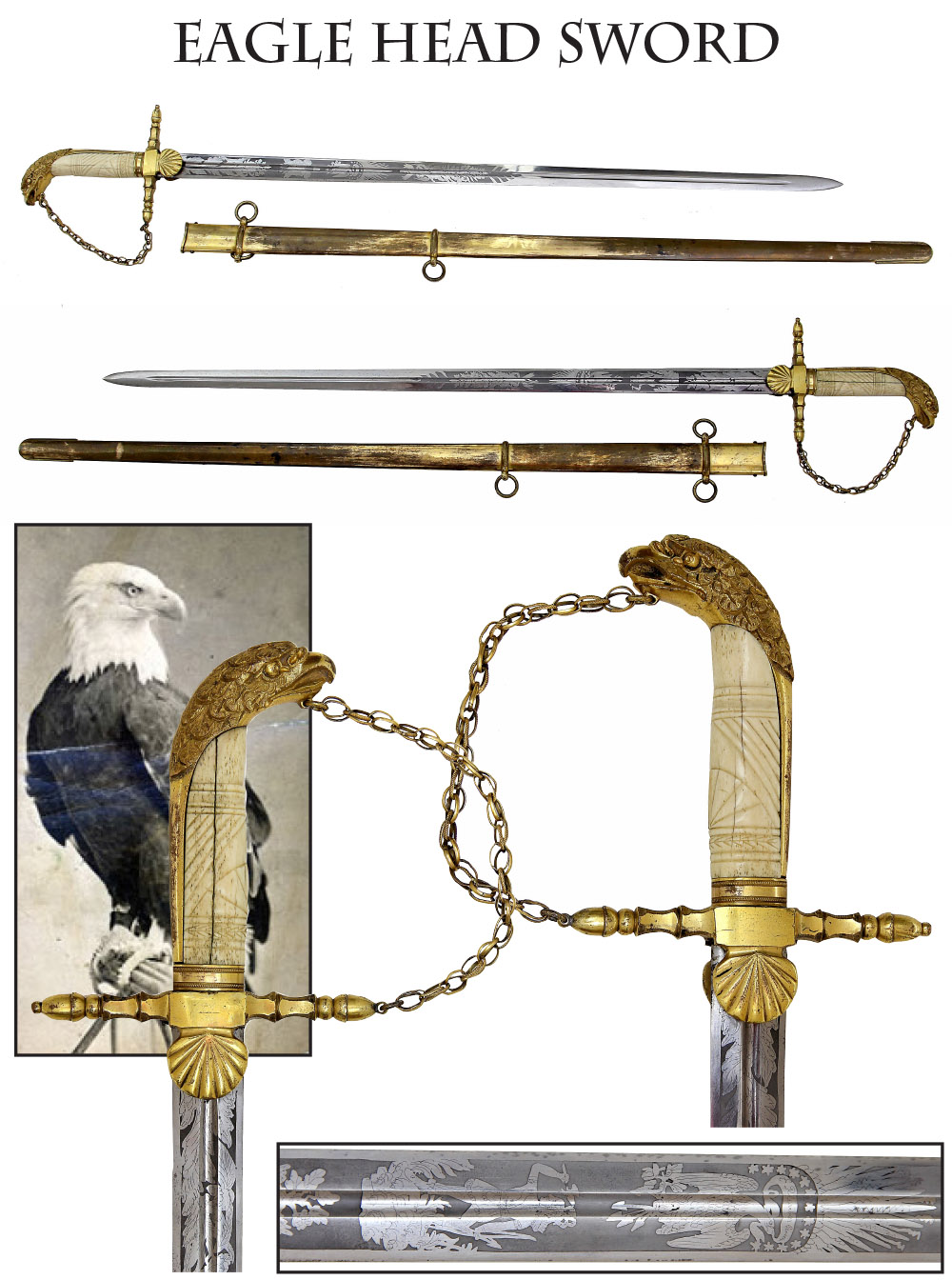
16-01-66 … Exceptional Ultra Attractive American Eagle Head Sword … Magnificent … as-found … beautiful … Super condition with loads of original gilt on the hilt and scabbard. The blade is near MINT condition. Bone grip intact… one longitudinal crack on one side … two inconsequential hairlines on the other,… solid and stable. Nicely formed curved neck eagle’s head pommel with plain back strap and chain guard connecting to one of two pineapple finials on the cross guard, which is straight. The eagle is as ferocious and handsome as any I have encountered. The guard is faceted and has to two downward turned shell-shaped langets. Grip has geometric incised lines. Superb, wide, straight double-edged blade with oval cross section and central fuller. Vivid beautiful etching on a minty bright blade. Has the usual floral motifs with a great US eagle and stars above and Indian brandishing a bow and tomahawk symbolizing America. Gilt brass scabbard shows about 40 percent bright, the rest a darker untouched patina. Throat, drag and all carrying rings present. A very nice sword of about 1840-1860 that would show very well in an edged weapons collection. One of the prettiest eagle heads I’ve owned. We offered this a few weeks ago at what I thought was a great price of $2400… that didn’t grab you so here it is at an incredibly friendly price. A great piece at a super price… bajj-eub … $$$ – SOLD
Call us @ 419-842-1863

16-01-67 … German made Saxony cavalry saber 1840 to 1861 … A good example of this German made sword and scabbard which was based on the British 1821 Pattern. 33.5″ slightly curved single fullered blade with early flat spine and a spear point. The sword is double edged for the last 8″. 3 branch steel hilt with rearward facing quillon. The guard is stamped F.A. 1884 1997. These markings are arsenal or armory markings, not dates. Shagreen covered grip bound with copper/brass wire. Steel back strap with ears fixed to the grip with a rivet. Domed pommel. The blade is nicely signed by maker Gebr. Weyersberg of Solingen.. Upper scabbard mount B527 and crown over FA. This is Friedrich Augustus II of Saxony. He reigned 1836 to 1854 (death). Separate throat is in place but lacks the two screws on the top and bottom edges. Still totally snug and secure. The blade and scabbard are free from rust and stains. Scabbard largely free from dents except for a smattering on the back side about eight inches above the drag. Very solid. The shagreen grip wrap shows expected wear but still solid and stable. In terms of Saxon military history that took place during Friedrich Augustus II reign… this saber may have been present during the 1849 May Uprising in Dresden in Saxony. Here is a synopsis from the lazy man’s best resource (Wikipedia) … “On 3 May 1849, the municipal guards were told to go home, but the town (Dresden) councelors organized them into defensive units to stop expected Prussian intervention. As the people’s anger grew, the government (Saxon) withdrew into the castle and the armory (Zeughaus), protected by Saxon troops. The municipal guards were undecided whether or not to support the people, who threatened to use explosives to get the government out. In response the Saxon troops fired on the crowd. Within hours the town was in chaos, with 108 barricades erected. In the early hours of 4 May 1849, the king and his ministers managed to escape and fled to the fortress of K�nigstein.” A wonderful early cavalry saber at a highly affordable price … abe-mil … $325.00 – SOLD
Call us @ 419-842-1863
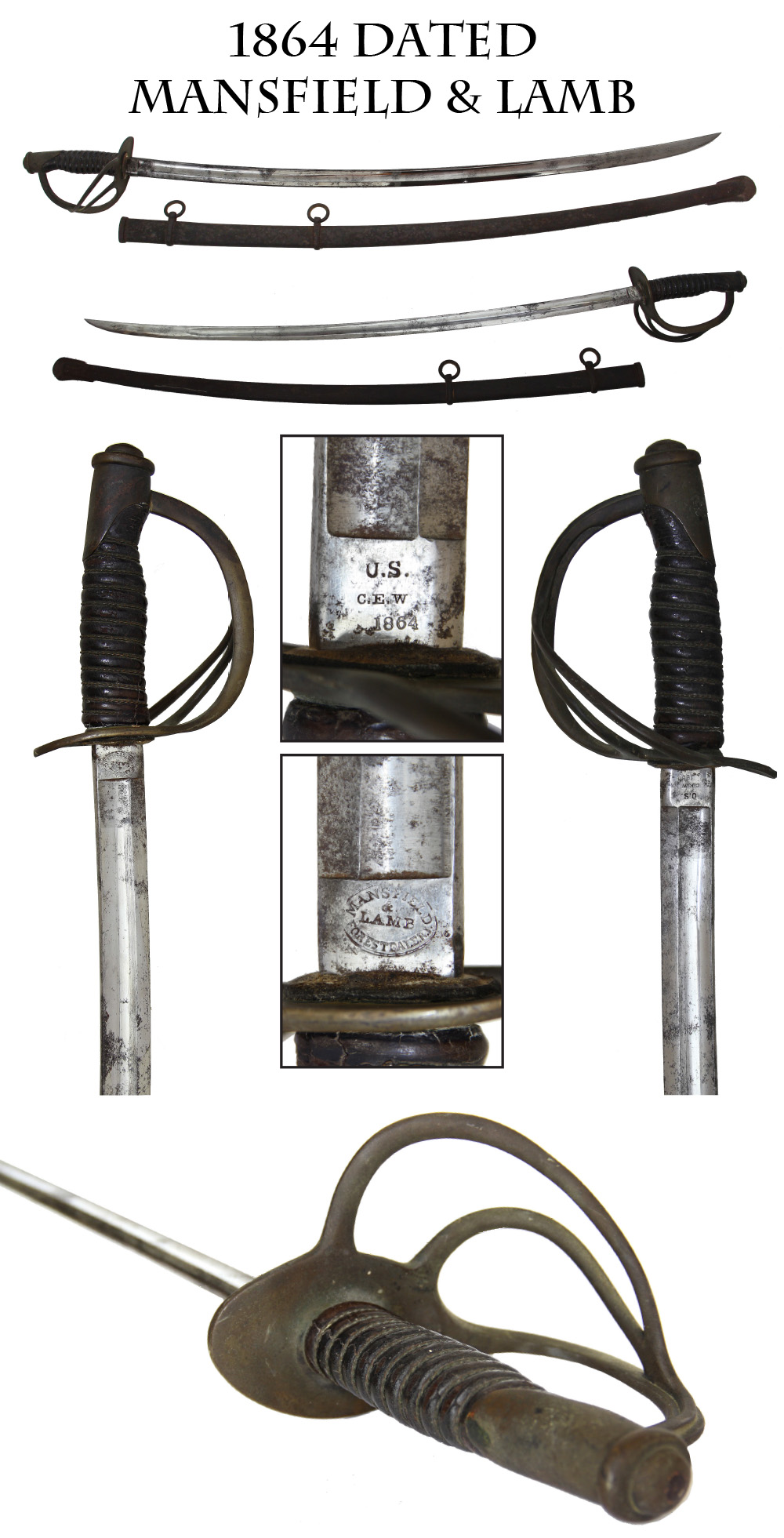
16-01-68 … 1864 Dated Mansfield & Lamb … Standard Union army issue light cavalry saber. US/C.E.W/1864 is clearly stamped on one side of the ricasso of this Model 1860 cavalry saber, and “Mansfield & Lamb/ Forrestdale RI” in an oval is on the other. Made in time for some of the toughest cavalry fights and raids, this saber has a bright blade with most of the original bright factory polish still present. There are a few age spots. Has a good clean edge and a good point. The leather pad is still present under the guard and the grip has nearly all of the original leather and the original wire in place and tight. The brass has a nice untouched, aged patina. The scabbard has throat, drag and rings in place and is “in the brown” (has a rust brown patina) with moderate pitting on the drag. A nice untouched cavalry side arm the way we like to find them: un-messed with, just brought home by a soldier and put away. The essential piece in a cavalry collection. Much nicer than most we see. The blade is outstanding … fej-hal-130907 … $765.00
Call us @ 419-842-1863
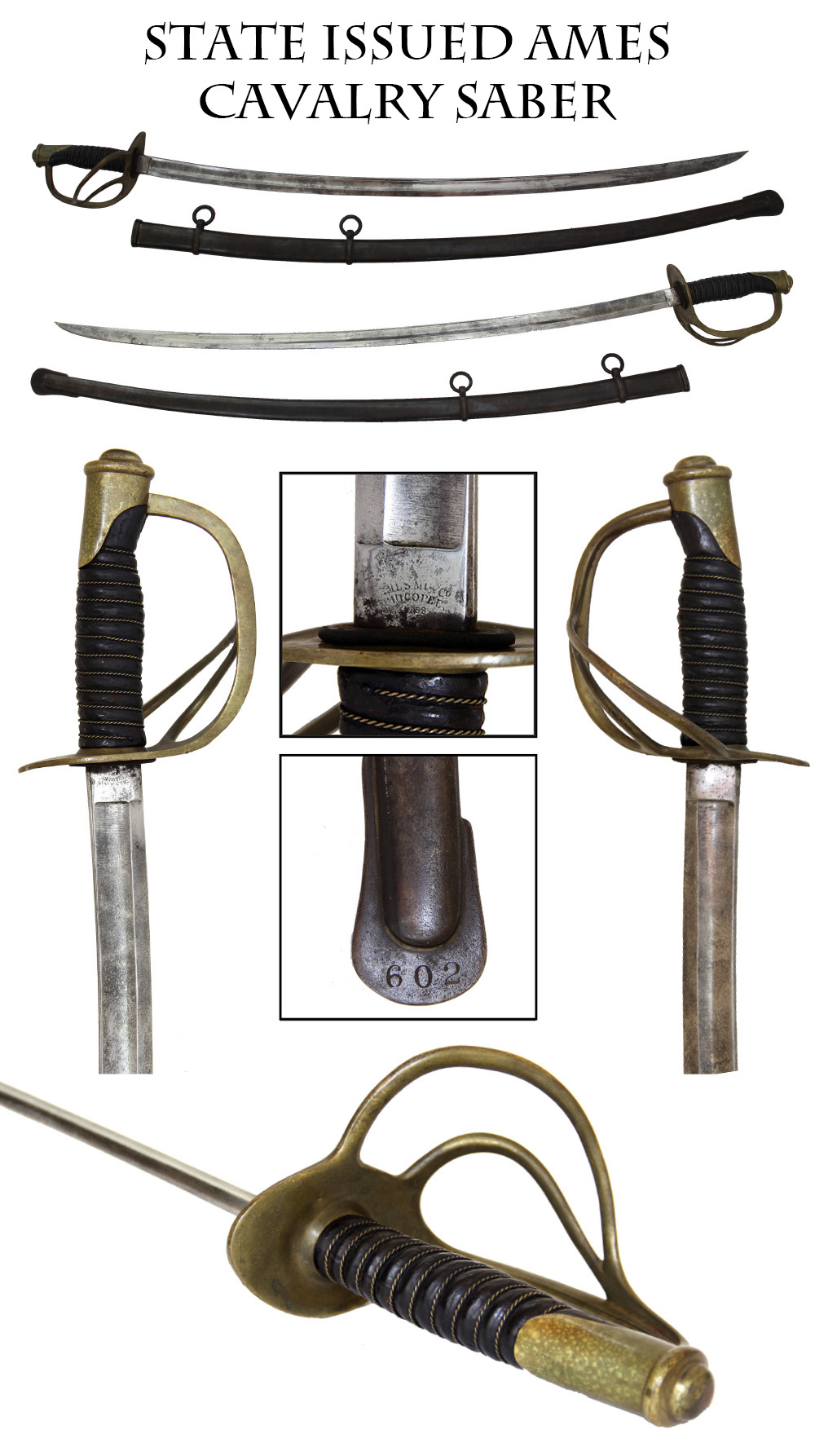
16-01-69 … Very Scarce Non-Federal Ames Light Cavalry Saber … Undated and not inspected. We call them the model 1860, but they first appeared in 1857. This has the full Ames marking in an arc reading: “Ames Mfg. Co. / Chicopee/ Mass.” on one side of the ricasso and the other side, which usually has the US inspector’s initials and date if it were a Federal purchase, is blank, indicating it was purchased privately. This was purchased by a militia unit, or by a state and thus required no US marking nor any US inspection marks. This private purchase saber is far scarcer than federally marked examples. Retains the original black leather and wire wrap on the grip. Also intact is the leather pad at the blade shoulder under the guard. Mellow patina to the brass. Blade is bright mixed with dull silver and some gray clouding. VG blade with no edge nicks. Scabbard is complete with rings, throat and drag, gray overall with some brown coming up and some shallow dappled pitting toward the tip. A rack number “602” is stamped in large numerals on the drag, indicating issue to a unit of substantial size, or residence in a large armory. Most rack numbers are under 100 indicating numeration by company. A number of 602 would be at the regimental level … or perhaps an inventory number in an armory. In any event these state purchased or unit purchased Ames sabers are quite scarce. This one is VG condition and very solid – noco-16759 … $695.00 – SOLD
Call us @ 419-842-1863

16-01-70 … Spanish American War Effects of Daniel L Miller, Co. H, 2nd Regiment, OVI … Nice family archive of material related to Spanish American War soldier David L. Miller, who enrolled in April, 1898, in the 2nd Ohio Infantry. His father a Civil War veteran. In 1898 Daniel Miller signed up for two years and served until the regiment mustered out in February, 1899. His discharge paper is preserved in the group. His military service record states he is noted for honest and faithful service. He served in Co. H, which recruited in Bloomdale. Miller also preserved his infantry corporal chevrons, white on blue wool, in good condition, and his mess gear: his 1874 pattern army cup with his initials and company letter scratched in the bottom, his folding mess tin with locations the regiment was stationed scratched inside the bottom portion, and his spoon, fork and knife, the last two with their leather sleeves. Also present is an example of the fabled army hardtack cracker in a folded envelope in the mess tin. It is still there, but a little worse for the years- broken into a number of pieces, but still a good representation of army fare. Along with these items he kept his comb, which has his initials and unit along the top. The neatest artifact is a red and white towel with Miller’s name and unit stitched into it along the lower edge- a neat piece of camp gear of which very few have survived into the 21st century. Also included are three photos of soldiers who must be friends and likely even include him. One view is a camp scene of five corporals outside a tent, with knapsacks arranged behind a stack of guns clearly showing the regimental number “2.” A second group shows the same five corporals posed in studio view with an Ohio photographer’s stamp at bottom of the cabinet card. The last is a tintype showing three soldiers in a studio shot imitating a camp scene. They seem to be a sergeant, corporal and private. Miller also kept some souvenir cartridges, an Ohio National Guard marksman medal, and a small box with some Ohio buttons and thread. There is a fragmentary Indiana CW veterans’ reunion ribbon with a celluloid portrait of Lincoln, an Ohio delegate badge, a printing block with McClellan’s portrait, a small round tintype of a man (his father?) in civilian clothes that looks about 1860 and a civilian powder flask of the same period. The powder flask is accompanied by a brown ink tag reading “Powder flask J. W. Miller 1861 to D. L. Miller”… dad was a CW vet and son a SAW vet. Miller’s service was entirely in the states. The regiment spent most of its service at Camp Thomas on the old Civil War battlefield of Chickamauga in Georgia. However, by August, 1898, living conditions at the camp had deteriorated to such a degree that units stationed there were relocated and the 2nd OVI was sent to Knoxville, Tenn., where it would remain until February, 1899, when it was sent to Macon, Ga., for muster out. Fourteen of their comrades had died of disease, a sacrifice for their country even if not made on a battlefield. Miller may have been involved in creating a history of the unit or with its reunions. A typewritten company roster of the original members of the company appears on the reverse of a piece of Goodyear and Miller stationery. An interesting grouping with lots of pieces and very displayable. I have offered these twice earlier… once around a thousand dollars once at eight hundred dollars…. Let’s try them at stupidly low price of … $695.00 If they don’t sell here I will put this set in my will to be buried with me. This is a gift at…. $695.00
Call us @ 419-842-1863

16-01-71 … Artillery Officer’s Saber Made for US Market Likely S&K … An interesting artillery officer’s saber that is unmarked but shares characteristics with Roby and S&K versions. Artillery officer’s sabers are scarce because of the small number of officers in that branch of service. Examples made by Ames, if you can find one, cost the price of a new Chrysler 200. Interestingly the 1841 regulations recognized this pattern for use by ordnance officers and “mounted officers artillery and infantry,” i.e., light artillery officers of all ranks and infantry officers holding field and staff rank. This changed in the 1851 regulations where the pattern was designated exclusively for artillery commissioned officers. This example conforms to the Thillman Type-2 with a conventional scabbard with articulated throat. It is completely unmarked other than a small stamp on the ricasso. The grip is leather wrapped with standard twisted wire binding. The leaf design on the pommel and on the knuckle guard match up with those of Roby as well as Schnitzler and Kirschbaum (S&K) products. The blade is plain, unetched, with a good edge and light silver in color with some bright showing through overall. The scabbard is a pewter gray with some darker gray areas, but no dings or dents. The grip is formed by turned wood and the scabbard throat is soldered rather than riveted, both American characteristics. S&K supplied hilts to other makers according to Thillman… and it appears that this hilt is one of those. This sword was likely assembled in the US by a military goods dealer utilizing imported and American elements. It is a very scarce regulation sword in extremely good condition and suitable for any edged weapons collection, or an artillery display from the Mexican War through the Civil War. Wonderful example … noco … $1,250.00
Call us @ 419-842-1863
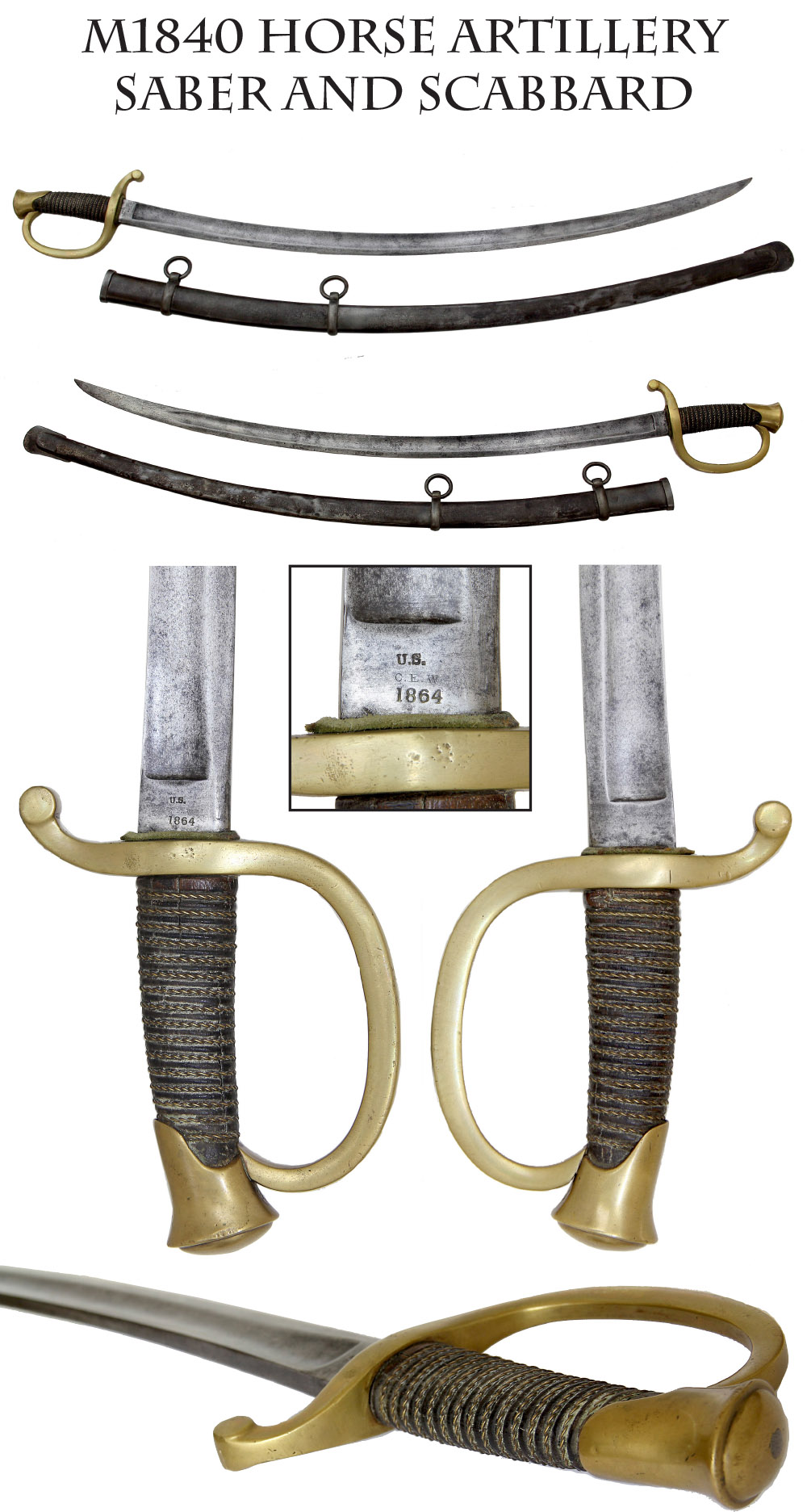
16-01-72 … US M1840 Light Artillery Saber and Scabbard … The light artillery saber was meant to offer the mounted drivers in light artillery batteries, and all personnel in horse artillery units, a weapon for personal defense. Here is a nice example, 1864 dated and inspected. It was certainly made by Ames, but the Ames mark is too light on the ricasso to make out readily. The date and inspector marks are sharp, but the Ames scroll maker marks can be extremely light as is the case here. The grip leather and wire are good and tight, just a slight bit of wood exposed at the guard with a rubbed patina from the leather shrinking. The brass is medium dark in tone. The blade washer is in place. The blade has a good tip and edge. Bright mixed with silver gray overall. Scabbard is in the bright, with darker color on the outboard side on the lower portions. The left side has a couple small dents. Carrying rings and throat are firmly in place… ejj-17067 … $695.00
Call us @ 419-842-1863

16-01-73 … Two Charleston Harbor Cannoneers� Effects / Only One Came Home! …
Rhode Island Historical Documents and Related Items Including General Burnside�s Autograph, maybe that of President Hayes, General Terry, and a Wartime Artillery Fire Table Written in the Field. A really interesting lot of ephemera related to Rhode Island brothers James Allan Seaver (1841-1896) and William Henry Seaver (1837 or 1839-1865.) One made it through the war. The other died literally almost in sight of home. Many of the documents have separations at the folds that can be EASILY repaired using archival document tape. I am leaving that conservation for the next owner so I can sell this now.
The most significant piece in this grouping is James Seaver�s NCO warrant as third corporal in Capt. Van Slyck�s company of the 1st Rhode Island, signed by Ambrose Burnside. Seaver had been a member of Van Slyck�s prewar militia company, the Providence Artillery and went with it into the 1st RI Detached Militia under Burnside in the days following Fort Sumter. The warrant is filled out in bold lettering, with nice seal of RI in the upper left corner. Signed clearly by Ambrose E Burnside on April 18th 1861, less than a week after the rebs attacked Fort Sumter. VG+ condition.
Seaver�s 1860 warrant as second gunner in the Providence Artillery is also present, datelined HQ Providence Artillery an signed by Van Slyck. About 6 by 8 inches with a RI seal. Seaver was discharged for disability on May 31, but enlisted again, this time with his older brother William, in the newly formed 3rd Rhode Island. The two brothers enlisted and mustered into Co. E on 8/21/61, James as a sergeant and William as a private. James made 1st sergeant on 1/15/64 and 2nd Lieutenant on 2/3/64. William was hospitalized in March and discharged for disability in late May, but served again later. The 3rd Rhode was an infantry regiment. They were sent south soon after organizing and took part in the Port Royal expedition and the reduction of Fort Pulaski, and then in operations against Charleston and the Confederate forts guarding it. Soon redesignated heavy artillery, the unit served largely by battery and in separate detachments performing varied duty as infantry, light artillery and heavy artillery. They saw frequent action. In addition to the above mentioned documents, this archive also includes �
*An Official Rhode Island document appointing James Seaver Lieutenant Feb. 1864. One separation at a fold.
*Discharge Paper James Seaver being discharged as sergeant in April 1864 to accept commission as Lieutenant in the same unit� 3rd RIHA. Poor condition separated at a fold into two sections.
*NEAT ITEM Letter 2nd Bn. 3rd Rhode Island Arty. Morris Island March 2nd 1864. Request by James Seaver to go to Hilton Head for four days. Carries numerous signed endorsements of approval on the back including an actual manuscript autograph of Alfred H. Terry. Good condition.
*Manuscript Special Orders March 4th 1864. Separated at the folds into three sections.
* NEAT ITEM Printed and Filled-out Pass to Fort Pulaski Chief QM Office Dept of the South. Hilton Head SC March 25th 1864. Pass the bears J A Seaver to Fort Pulaski. Good cond.
Perhaps because of his long experience with artillery, in March, 1864, Seaver was temporarily detached from the regiment and assigned to Battery D of the 1st US Artillery, a light battery serving in the 10th Army Corps in the District of Beaufort, S.C. How long he served with them is unclear, but there is a letter from him datelined �Camp Battery D 1st US Artillery, Virginia May 28, 1864� requesting he be returned to the 3rd RIHA. (Letter separated at a fold.) He certainly returned before the regiment mustered out: there is a manuscript special orders no. 3. HQ 3rd RI Artillery Hilton Head SC Sept 12 1864, regarding Seavers company about to be mustered out and Seavers� transfer to Co. C until his own muster out 10/15/64. This is followed by a Provost Marshal�s Pass. NEAT ITEM. Printed, filled in, and very striking. Dated Bermuda Hundred Oct. 12th 1864 passing Lieut. Seaver to Fort Monroe Virginia. Stamped �John Cassels Oct 12th 1864 Capt. & ADC Provost Marshal� and cancelled by perforations. Good cond. Most likely Seaver�s pass to go home.
Three further pieces relate to William H. Seaver, who was not as lucky as his brother:
*Discharge Paper William Seaver 2nd Bn. VRC dated June 16 1865. Good cond.
*Letter from a US Army Surgeon to James A. Seaver acknowledging William Seaver�s death at a Rhode Island General Hospital, regretting he did not get to see his home again, although so close. Bears US Med Dept Logo in upper left corner. Printed in upper right �Lovell General Hospital USA Portsmouth Grove, Rhode Island��. June 19th 1865. The letter states that Wm Seaver died, �� his days had been numbered�� and asks, if a post mortem was conducted, to send him the results to see if his diagnosis was correct. Very weak at the folds with some paper loss, but a telling document.
*William Seaver�s wallet. Leather large size wallet nicely ink inscribed to �William Seaver Jr.� (This must be William H., named after his father, who had died in 1859.) Excellent Condition. William Seaver likely had additional war service. Researching the database I find a William H. Seaver serving in two other Rhode Island units after our William H. Seaver was discharged from the 3rd RIHA: a private in the 7th RI from 7/14/62 to 3/2/63; and a private in Battery F, 1st RI Light Artillery from 6/22/63 to an undetermined date. The 7th RI private was also discharged for disability, and the date the Battery F private enlisted might be a mistake for 5/22/63, the date given for William�s enlistment on his VRC discharge, so there is a chance these are all the same William H Seaver� James Seaver�s older brother. This would explain how he ended up in the VRC in 1865. There may be a good story here. Perhaps an attempt to live up to his younger brother�s record. In the grouping are a number of other pieces.
*1877 Rutherford B Hayes signed pre printed letter on Executive Mansion stationery. Separated into three sections� one separation directly through Hayes autograph. DAMN!
*Pay voucher separated into numerous sections.
*Albumen photo James A Seaver in the uniform of the 1st Regiment Light Infantry Regiment. A post war photo. VG cond.
*An 1877 printed Dept of the Interior letter separated at the folds.
Perhaps the most fascinating piece is a large 8 x 13 manuscript firing table kept by James Seaver. One of the coolest soldier documents I have owned. Titled, � Table of distances from Cummings Point to the Batteries in Front� with a list of the forts and the number of yards to each. Charleston Battery was a whopping 6,710 Yards� Castle Pinckney 7800 yards… Ft. Sumter a close neighbor at 1,480 yards� Another box of data tells how much fuze to use with a 30 Pound Parrott Gun. Other columns are Fuze, Elevation, Powder. Separated cleanly at the folds into four pieces. Displays like a million bucks. I love this artillery personal item. An interesting family archive with room for plenty more research. The Burnside signed commission and the manuscript firing table are worth the price of admission … $950.00 – SOLD
Call us @ 419-842-1863
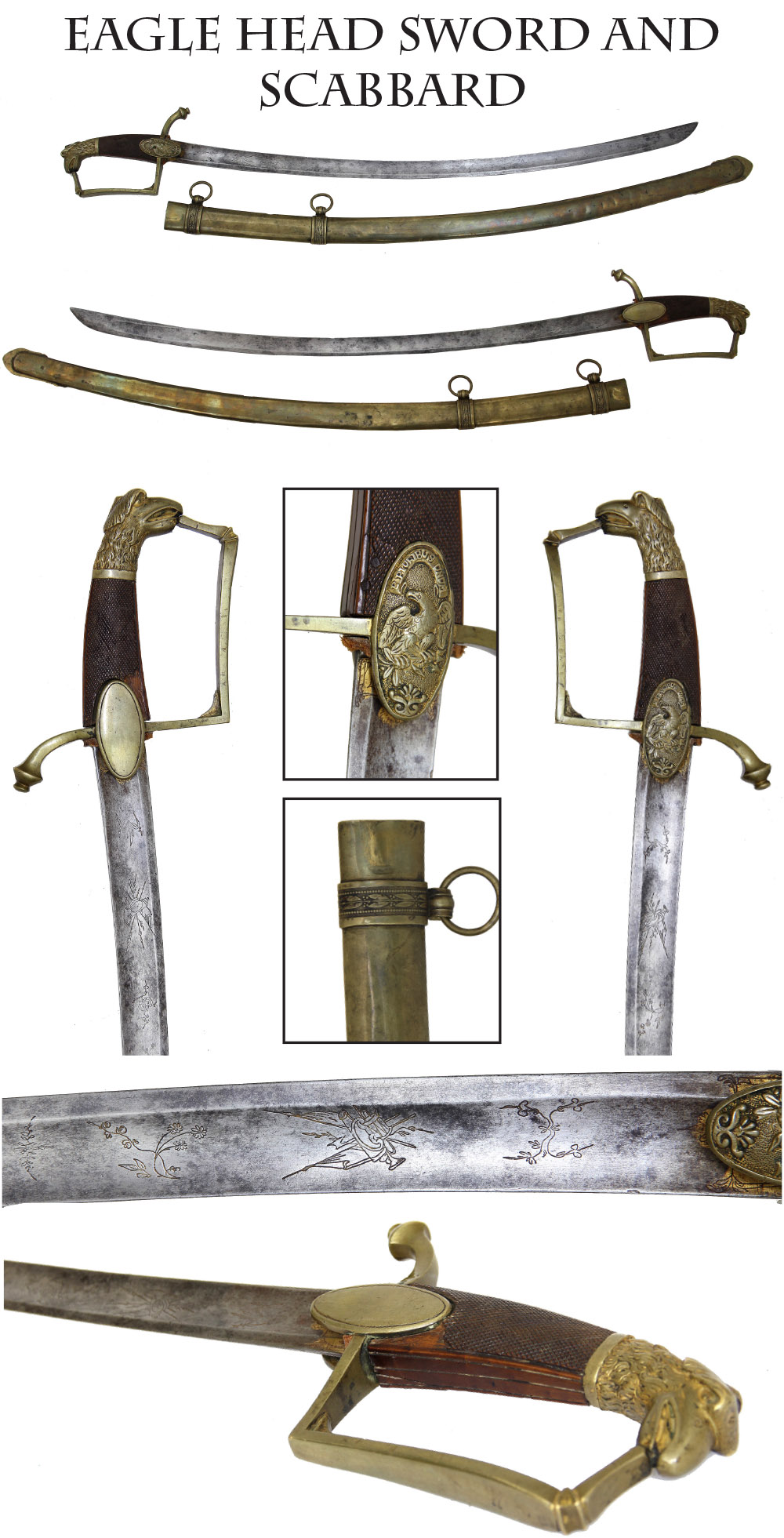
16-01-74 … Wonderful Mexican War era American Eagle Pommel Sword … A truly handsome “eagle head” circa 1830 to 1840, and even more attractive as it resides in the fine original solid brass scabbard. Overall length about 36 inches. Pommel is cast with a decidedly French form eagle’s head. Grips are a handsome checkered polished horn. The blade is etched with military motifs and retains traces of the gold inlay. Overall very good condition, with grip missing a small chunk on the rear, and a couple ancient tacks are present from an old repair. The obverse langet is decorated with a ferocious full form American style eagle and “E. Pluribus Unum”. This sword was manufactured in France for the American market. One of the more handsome of all American edged weapons, these early “eagle heads” are still totally affordable and infinitely collectible as there are hundreds of variations to collect. Here is a great piece to add to your arms collection … Looks super hanging on the wall. Many times more handsome than an 1850 staff sword, many times more rare, but priced the same as a CW staff sword … ae-/kutch … $1,495.00 – SOLD
Call us @ 419-842-1863
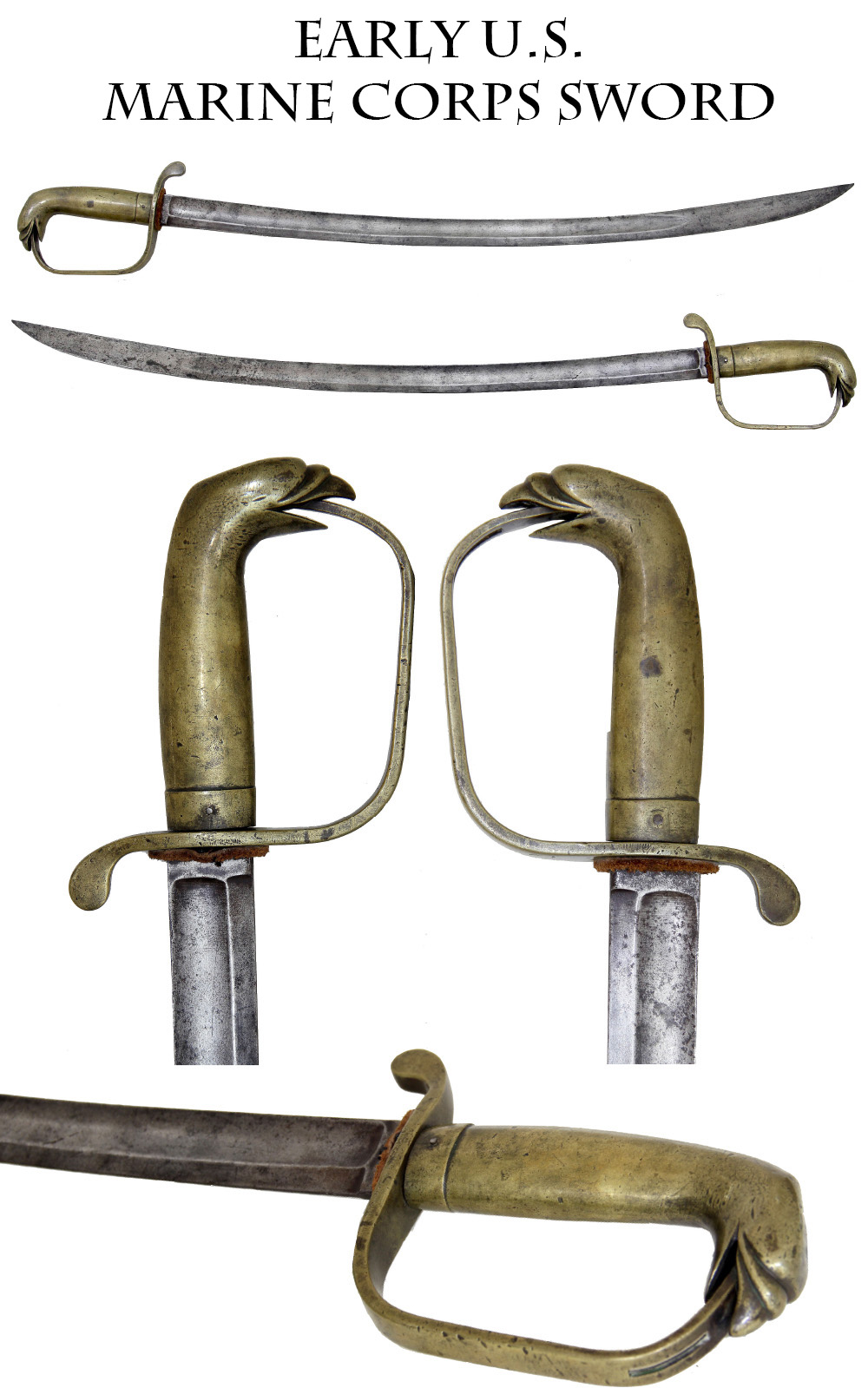
16-01-75 … 1830s-40s Marine Corps Musician’s Sword: These solid-brass hilted eagle pommel swords were unidentified for many years until Norm Flayderman turned up sketches of swords in the work books of the Widmann Sword Factory in Philadelphia. The books were brought by a workman of Widmann’s to the Horstmann Company after Widmann’s death in 1848 when Horstmann incorporated the Widmann operation into his own. In those sketches are the Marine Corps Sergeant’s sword and the Marine musicians sword made in two lengths: They were titled in the book the “Marine Music” sword and the “Marine Music, Boy” sword. Both show similar stylized solid brass eagle-head short swords. With no further documentation available from historical paperwork some present day scholars feel that the design may in fact go back to the 1830s or even 1820s due to the early style of the eagle. The form of the eagle’s head certainly appears to be 1820s. Ours has a gently curved blade with a single broad fuller and a very narrow ricasso. There are no markings of any kind. The 25 inch blade shows bright mixed with a very light gray. The hilt has a nice untouched deep patina. Ours differs slightly from the Widmann-Horstmann sketches in having a D-guard rather than a P-guard, and this is the second such example I have owned with the D-guard. We are in pretty much uncharted territory trying to report historical data, since no published regulations have turned up describing any of these USMC swords, just the 175 year old sketches that uncle Norm found. The knuckle bow also has a slot for a sword knot, just the sort of ornamental touch one might expect on a musician’s sword. This is classic Philadelphia style architecture on the grip and eagle pommel. Unmistakably Philadelphia. A scarce form of eagle-head, and a rare sword. No scabbard. 30 inches overall length … xzz-kutch … $950.00
Call us @ 419-842-1863
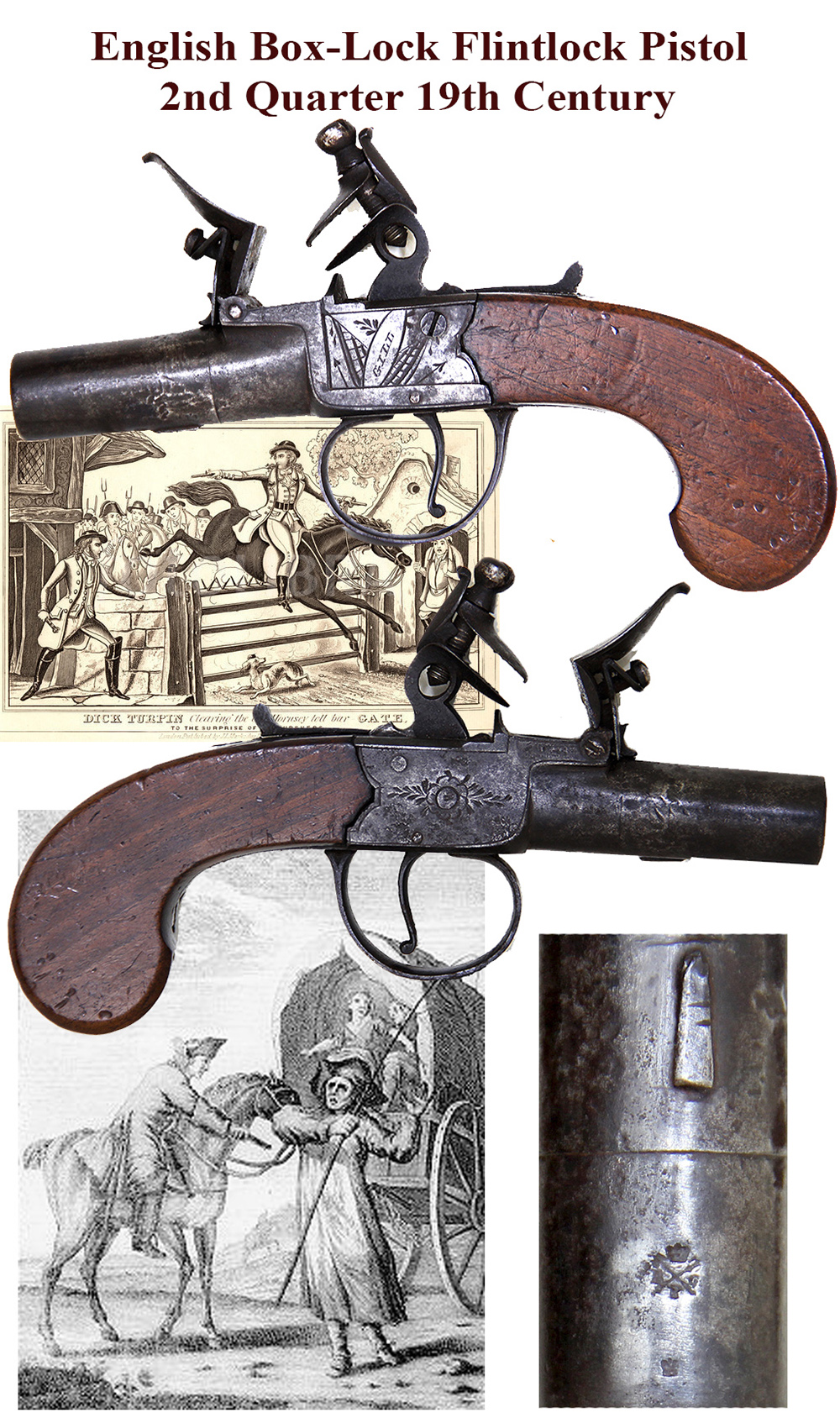
16-01-76 … English Box-Lock Flintlock Pistol by Gill … Near fine condition… These were the British derringers of the early era: small pocket pistols that could be carried discreetly for self-defense by gentlemen in town, travelers, and even the military officer: Stephen Decaturhad a pocket pistol something like this when he shot a Barbary pirate he was wrestling with in a close-quarters boarding action. Plain, flat-sided grips with some dings and handling marks, but no breaks. 6 ¼ inches overall, about.45 caliber. Nice marking of “Gill” (the well known British arms maker anddealer) between some rudimentary flags, etc., on the side plate. Short turn-off barrel with lug enables the pistol to be tightly loaded at the breech, meaning it can fire a “forced ball” with much greater power at short range than you would think. Faded blue on the steelgiving a stronger purple toward the muzzle and mixing with gray toward the back. A nice little gun … $550.00
Call us @ 419-842-1863

16-01-77 … 1880s Counterfeit Remington Double Deringer … An exact period copy of Remington’s .41 caliber rimfire two-shot deringer, probably the most recognizable pocket pistol in the world thanks to Hollywood western movies and TV shows. Top of barrel is marked with full Remington firm name and a patent date of 1863. But it isn’t Remington’s mark. It is an imitation or counterfeit marking struck in an odd die style … likely European. The pistol is made every bit as well as a Remington, possibly better as this one does not have any crack in the hinge as seen on a large percentage of the Remington made guns, This model was extremely popular and was first produced by Remington in 1865. This patent infringement, counterfeit, Knock-Off was made around 1870 to 1880 and will make a super companion piece for a display of real Remington derringers in a Wild West display. Very good rosewood grips, about 40 percent remaining of original nickeled finish on the barrel assembly, barrels are smooth bore. Receiver a deep gray/brown. Batch number “22” on the barrel. Lever in place on right side. Handy to have at hand when your four kings and an ace get beaten by four aces and a king … $595.00
Call us @ 419-842-1863
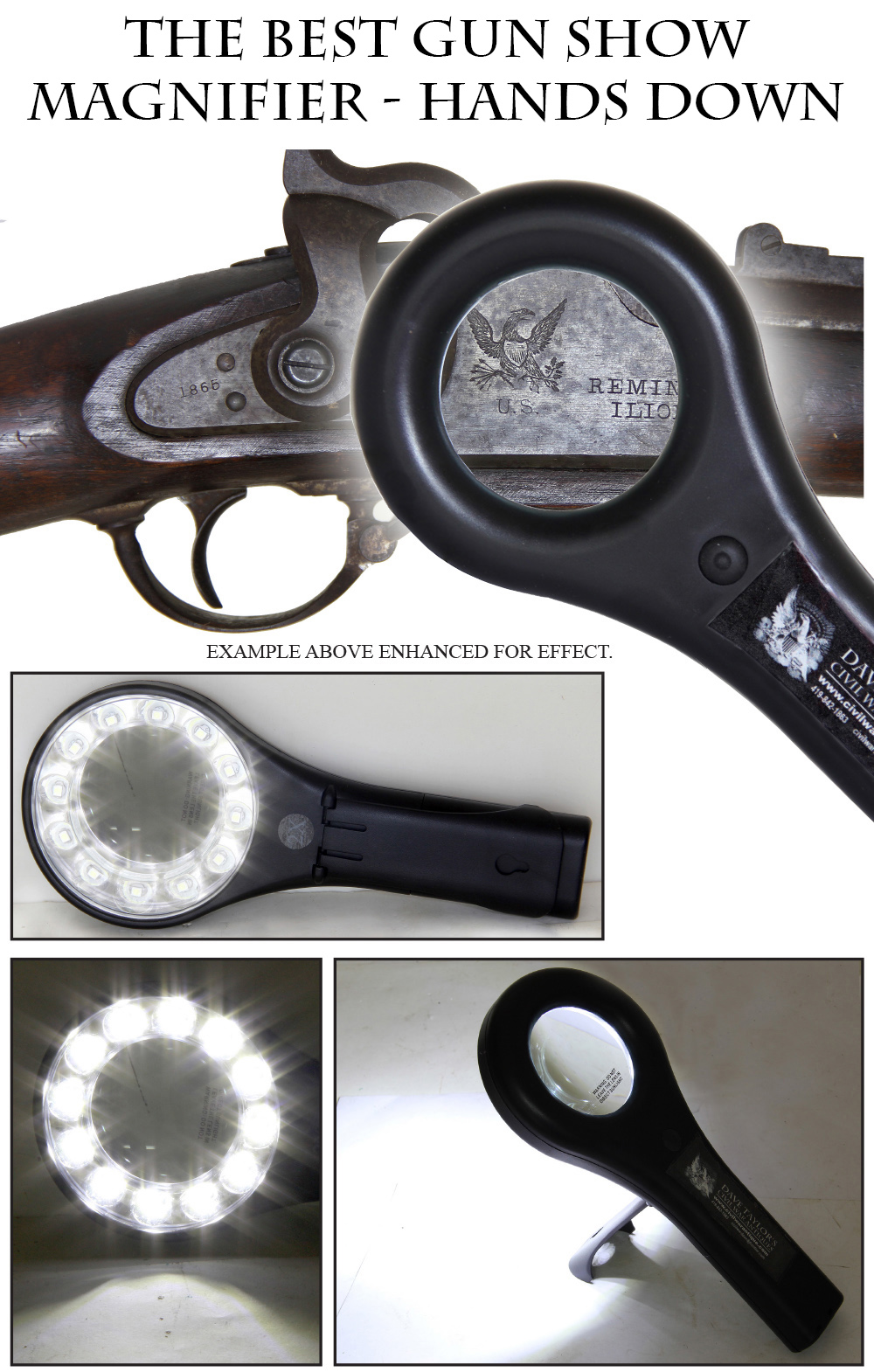
16-01-80 … INCREDIBLY EFFECTIVE LIGHTED MAGNIFYING GLASS / PERFECT FOR INSPECTING ANTIQUES … You have undoubtedly seen collectors at the shows running around with one of these magnifying glasses in their hand. There’s a good reason … they are SUPER! Months ago I bought one for myself and loved it. Then the local guys wanted one and I bought another half dozen for them at $25 each at the next show … Then I bought another one for me when I arrived at a show and discovered I’d left mine at home. I figured with as many as I was buying at retail, I might as well buy them in bulk and sell them at the shows and on the web page. These are absolutely essential for anyone buying antiques at shows or auctions. The intense illumination from the twelve LED light sources and 2x magnification exposes “artificial age” such as cold-blue on metal or amber shellac on wood. Shine this light and you will see if someone has “aged” or repaired the item you wish to buy. The magnification accompanied by the intense illumination reveals cracks and repairs that the naked eye cannot pick up. Requires 3 AA batteries (not included) … $25.00
Call us @ 419-842-1863
Layaways are Welcome
Need to split your order into multiple payments? No problem! A simple 20% earnest money deposit will hold your item for you.-acf
You can then pay it off in easy installments that fit your budget.
Read Terms Here
Items to Sell? Contact Us
I am always interested in buying ANYTHING from the American Civil War… Guns, Swords, Civil War Muskets, Knives, Uniforms, Flags, Medals, Badges, Diaries, Letters, Autographs, Buttons, photographs, tintypes, daguerreotypes, Insignia, Camp Items, Battlefield Relics, canteens, Drums, Etc… Call 419-842-1863 and ask for Dave Taylor.

